Scattered across the internet for years, what will we find?
Announcement
Collapse
No announcement yet.
Pinky's recipes
Collapse
X
-
From 9-1-12
blueberry buttermilk applejacks
After last weekend's stupid food reaction fiasco, I decided we're having extra special *good* stuff at home, yay! I'm always making new stuff that beats restaurant food so I don't feel so depressed that I can't enjoy eating out any more.
My fave pancakes growing up were apple jacks, Scott loves blueberries, and who doesn't love buttermilk? So here you go, slaver over this easy awesome do-it-yourself gourmet pancake. To a cup of your fave pancake mix (I used Bisquick) add a half teaspoon of cinnamon and whisk in. Add a little lunchbox sized container of applesauce, one egg, and a couple splashes of buttermilk, whisk thoroughly. If it's too thick, splash a little more buttermilk, if it's too thin, add a little more mix. Pour a little onto a hot lightly oiled griddle, sprinkle on some blubes (frozen is fine, mine were homegrown at my sister's house), and cook like for regular pancakes.
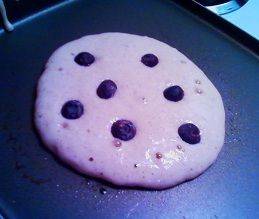
These are particularly moist but still manage to fluff up a little bit, and they smell like a holiday breakfast.
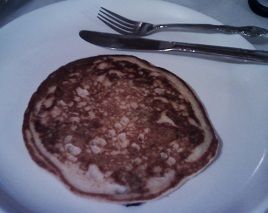
These are the cutest tiny little eggs from my new hens, started laying just this last week. Organic free range at home *always* tastes so much better than restaurant eggs.
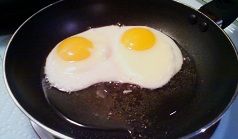
Scott doubles up on the blubes with homemade blueberry jam that my sister made. I've experimented with all kinds of bacon, the best for getting crispy (for me) seems to be Farmland lower sodium, no idea why.
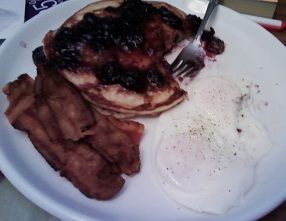
This is the best way to squelch that 'poor me I have multiple food allergies and can't eat in restaurants without major weird cross contamination' depression, and you can do nearly anything you want with other flavors for all kinds of pancakes. Might seem simple to foodies, but when we get busy it's easy to forget how easy it is to enjoy something really good. After last weekend's stupid food reaction fiasco, I decided we're having extra special *good* stuff at home, yay! I'm always making new stuff that beats restaurant food so I don't feel so depressed that I can't enjoy eating out any more.
790: You're wasting your energy attempting to force my cooperation.
I have no sense of self-preservation and I can always be reassembled.

-
From10-7-12
really good chicken soup
Chilly weather coming on is perfect for this hearty provincial chicken soup. Start with 2 cans of chicken stock (or about 3 1/2 to 4 cups frozen premade stock), cut 1 large celery stalk and 1 large carrot into big pretty chunks and simmer in the chicken stock until a fork can pierce to the center. While that simmers, squeeze 3 brats (your favorite flavor) out of their skins and brown in a skillet, breaking into small chunks as they cook, drain and set aside. When vegetables are starting to get tender, peel and cut up a large potato into the stock and keep simmering until potato is almost soft. While that simmers, shred or cut up 1 large or 2 small leftover roast chicken breasts. When potato is almost soft, add 1 cup water to stock, then add cooked brats and chicken, heat through. Do NOT add salt! Pile fresh spinach leaves into bowl, ladle soup over, sprinkle liberally with grated parmesan. This soup is very flavorful and is our favorite basic soup. You can also add any other leftover vegetables, beans, or rice for variety, or a little cream for a cream soup.
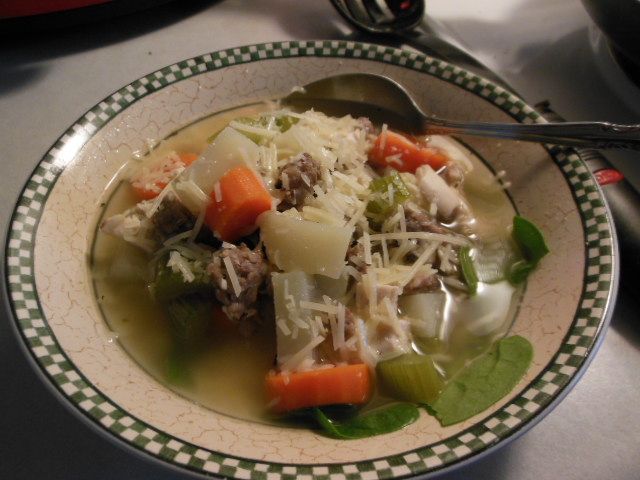
790: You're wasting your energy attempting to force my cooperation.
I have no sense of self-preservation and I can always be reassembled.

Comment
-
From 10-14-12
Italian Chicken Fingers
A couple of loyal readers who have been following my bluejacky blog already know from reading my silly little surveys that I have cooked professionally in both a big restaurant (400+ capacity) and a posh lounge, and that over the last two years have suddenly developed a ridiculous array of food allergies to the point where I can no longer eat in restaurants myself. I decided that the only way not to feel sorry for myself was to make everything I eat at home taste *better* than any restaurant I've eaten in (or cooked in), and believe it or not, I've wildly succeeded in these little babies.
Italian Chicken Fingers
Measure one part plain packaged bread crumbs (or flour, if you don't have bread crumbs, note that panko won't work that well with this recipe) to one part ground parmesan into a breading dish, about a cup each. Mix well, breaking up the parmesan lumps, adding a big dash each of black pepper and garlic powder, a tablespoon each of dried thyme and dried oregano, and a teaspoon of smoked paprika. I personally prefer McCormick spices because I think freshness, consistency, and quality make for better tasting food. I'm not being paid to say that, just saying, as someone who does a LOT of cooking.
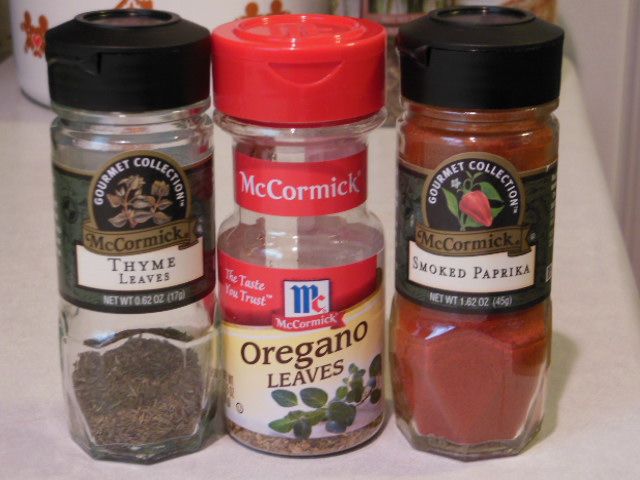
Open a package of chicken tenders and lay them out on a plate. I like to peel the transparent skin off them first, the finished texture is better. Lightly salt them only on the side that is facing up. Break two eggs into a small bowl and whisk them with a fork until they're all one color. Your ingredients are now assembled and ready to cook.
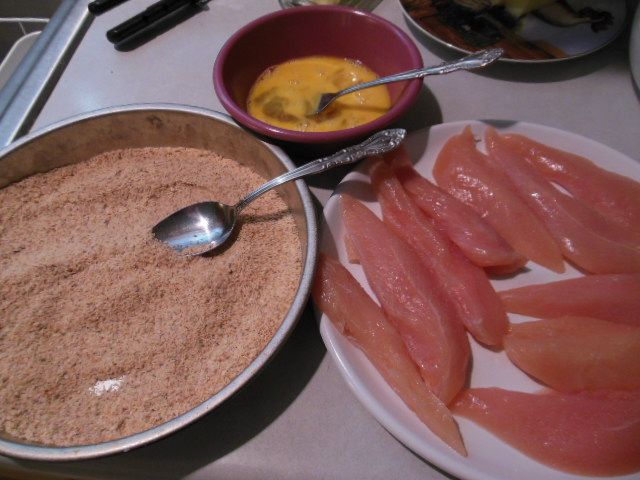
I normally use 100% canola oil for frying (1200+ mg. omega-3 in every tablespoon!) because it has a high smoke point and because I'm too sensitive to other oils, like corn and especially peanut. However, to punch up the flavor even more on these chicken strips, I fry them in leftover bacon grease (which also adds a little more salt). I never heat a nonstick frying pan above medium heat because some of them have warnings about the integrity breaking down under higher heat (and that can mean that toxic fumes might cook into your food, but I'm no expert, just cautious, and really tired of my pans breaking down). Your pan will get plenty hot if you are patient. When a pinch of the bread crumb mixture starts sizzling, your oil is hot enough to start cooking.
Dip a chicken tender into the egg with a fork, then transfer it to the crumb mixture and pat mixture firmly onto it, then lay it into the hot oil. Repeat with all the chicken tenders or until the pan is full, finish what's left in another batch. Cook for 2-4 minutes (depending on how hot you've got your oil) and turn over and cook until all sides are browned and crispy. Don't overcook or your chicken will dry out and be tough. Chicken tenders cook through much faster than regular sized chicken pieces. If you are unsure, cut the biggest one in half to make sure it's not still raw in the middle. If it looks done, the rest are done.
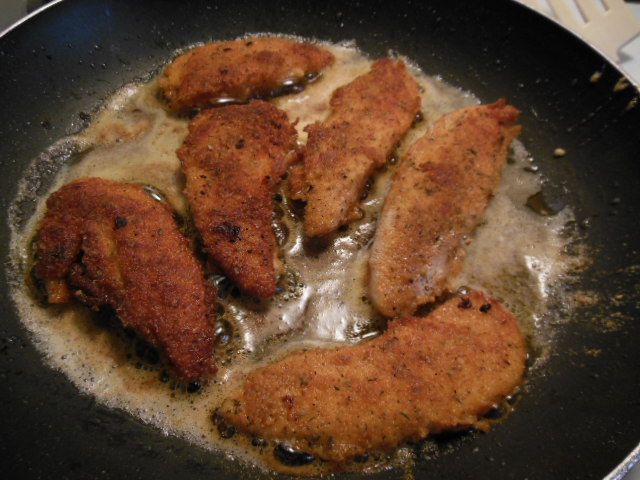
Lay the cooked chicken tenders out to drain on paper or a rack over a plate, and try to wait till they're cool enough to eat. I've burned my mouth because the wonderful smell was too much to take.
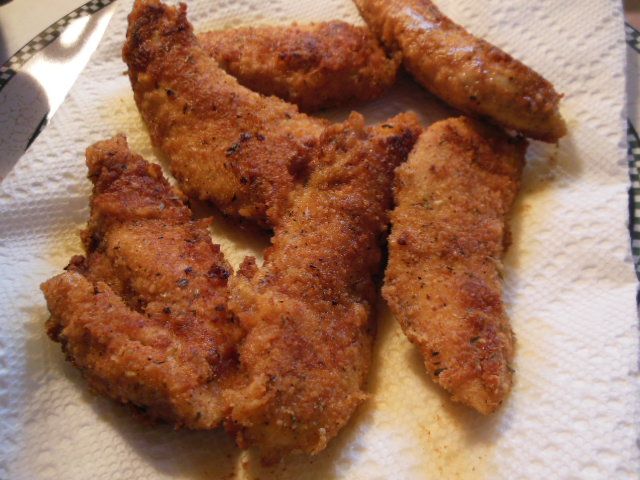
Remember scratch 'n' snif? Someday when we all have internet implants in our brains we'll be able to experience a smell and taste sensation by mentally clicking on a food picture we see in our heads. Too bad you can't taste this right now, it really is good. Go make some!
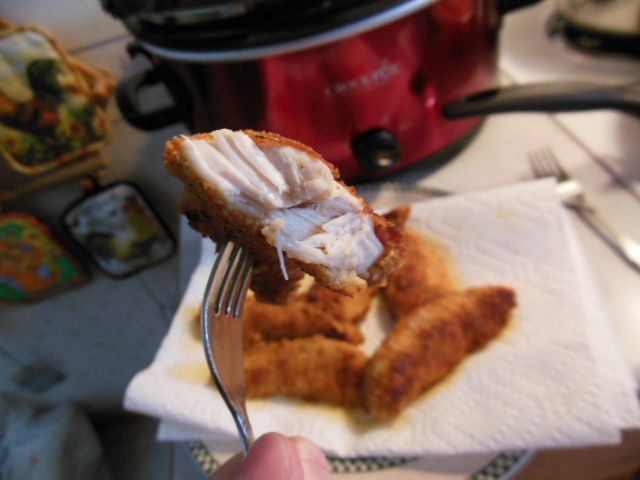
790: You're wasting your energy attempting to force my cooperation.
I have no sense of self-preservation and I can always be reassembled.

Comment
-
From 11-14-12
Holidays with Diabetes- Easier Than You Think
I'm not a professional dietician- but I AM wildly successful at controlling my diabetes without meds. Before you blow me off, let me just say my mother wasn't. I have plenty of incentive.
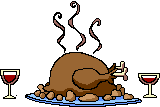
So you're invited to a huge feast, and you've got diabetes. Or you're cooking for a big crowd, and you've got diabetes. The social pressure is on to stuff your face, and every cell in your body strains for the magical sensation of sweet and savory, tart and salty, the nostalgic flavors and aromas and all the good cheer that food can bring, because, let's face it, sometimes that's the best part of getting a lot of people together. Some of you will argue that the booze is the best part at this point, to which I give a polite nod.
At every feast, it's cool for people to say they ate themselves into a coma. Have you ever wondered why you get so sleepy after lots of food? It's not the turkey! Ever since I got a glucose monitor and became a little scientist, I have been mapping the feel goodity of food. And I discovered something just a little scary- the sleepy 'coma' feeling usually comes after a big BIG carb load, and that's when your blood sugar goes way WAY high, despite any medications you might be taking to keep it down. Normal people think they can get away with this, but they get sleepy, too. What gives?
I think that sleepy coma thing is the same reaction as people have to drinking alcohol, namely, the body shuts you down before you can send yourself over a toxic cliff. You fall asleep! Carb processing takes a little time. A carb overload, as everyone knows, results in FAT when you don't use it up. So what's a little fat, it's just one meal, right? That isn't the problem. The problems is in between the eating and the fat. For about two hours after you eat, your body does a complete inventory of incoming proteins, fats, and carbs. Nothing sits around too long or it makes you sick, so the body is constantly processing. Sometimes you get a bigger than normal shipment in, it takes a little longer to unload the truck and unpack all the boxes, and during all this, your pancreas and liver are working overtime to make sure YOU don't get a toxic buildup of raw materials dumping into your bloodstream. Like carbs.
Carbs are necessary for energy, although your body can switch to burning fat and even protein when it has to. Any carbs not being used right now or in the immediate future have to be stored as quickly as possible, and since the pancreas and liver help with this filtering process, they overwork and get backlogged. If you've heard of 'fatty liver', this is one way people get it, and it's actually very common. Thanx to years of meds and diabetes, I have a liver condition called NASH. Many people have no clue they have a liver condition until their livers are very sick. I'm not paid to link this next site, but for the morbidly curious, it's pretty good info. Signs and Symptoms of Ten Common Liver Diseases
In the last two years, I have turned myself completely around, lost 50 pounds, and have the best blood work in years, plus I made it through holidays last year without gaining a single pound. I didn't exercise much last winter, either, although I'm not advising you to *not* exercise. I'm currently in a program at the fitness center and feel so much better. But what I'm saying is, even with diabetes, I flew through holidays last year without any blood sugar problems. HOW????
I think a lot of diabetics aren't aware that proteins and fats don't spike your blood sugar. They're also not aware that there is a big difference between fast carbs and slow carbs. It's really weird, but 'healthy' carbs that take longer to digest can actually keep your blood sugar higher for a longer time than fast carbs. Maybe you've heard of 'high glycemic' carbs. Those are legumes (beans), all grains, most fruits (berries are generally ok to eat), and the kinds of veggies that fall into roots (potatoes and carrots) and gourds (pumpkin and squash). On the other hand, leafy greens (letttuces and spinach), brassica (includes cabbage, cauliflower, broccoli) and a few other kinds of things that you might like in salads, like radishes and olives, barely bother your blood sugar at all. If you like charts, you can find a glycemic index of some kind all over the internet.

Here comes the easy part.
The real scientists who came before me have figured out you can get away with about 10 grams of carbs per meal or snack roughly about every two hours without noticeably spiking your blood sugar, unless you're completely insulin dependent because your pancreatic beta cells literally can't produce your own insulin. Basically, you can have a cup of milk, as long as you skip all the bread, potatoes, corn, gravy, stuffing, and dessert. THAT SUCKS, you say. Ok, ok, you're right, that sucks. But I still really figured it out. I am a cookie addict. For many years, I haven't made it through a whole day without a cookie. Or two... J'adore cookies! When I found out about the glycemic thing and the 10 grams of carbs guideline, I thought ah-HA, but they can't make me stop eating cookies! I would break a cookie in half and wait a couple hours and eat the other half. I wound up eating cookies all day long that way.
And that's the secret.
First of all, it was thrilling to see my random and then my fasting glucose drop down all by itself without medication or exercise. I tried meds for 11 days and the doctor pulled me off, turns out I am excruciatingly med intolerant. And at the time, I was also too exercise intolerant to move around a whole lot. I wasn't that overweight, only 236 pounds (mostly from steroid meds), but coming from several generations of diabetics full of all kinds of complications, I know you don't necessarily lose a leg or your vision before you lose your life. Or worse, have multiple strokes and lose your ability to function and wind up in a nursing home for years. Because that happened to my mom. She was on the sorta skinny side when the strokes hit, but her glucose easily hit the 300-400's all the time. Her blood stayed 'sticky' all the time from her inability to process carbs properly, and that caused complications galore. She loved her pop and her flavored coffee and breakfast sweets and holiday goodies and mashed potatoes and bread...
Remember, diabetes doesn't always make you fat, and plenty of bigger people don't even have diabetes. And remember, if you HAVE diabetes, YOU have problems processing carbs. Your poor body is trying to keep up.
When I got into the habit of breaking my carb loads down into much more manageable chunks, I discovered it was getting easier and easier to do it all the time, even during holidays. Once you get used to actually feeling better (seriously, lost 50 pounds in 4 months ~doing that~), you suddenly notice how gross you feel when you 'carb out'. Like headaches. Wow, I couldn't believe how that cut down my headaches. And heartburn. I spent years treating heartburn, and while everyone thinks it's from fatty rich foods, I have proof that a goodly carb load is miserating for heartburn spiking back alive after you haven't experienced it in awhile. Also, my skin problems went away all by themselves, my liver enzymes went back to normal, my hair started growing in better, and I started feeling so much better that I was able to get out of the house and go shopping again. I went from driving a mobile cart around the store to walking around, and now I can walk all over a store before I get tired.
See, when you constantly carb load with diabetes, you are diverting your body's priorities away from other things, because your body is constantly working on *saving your life* (and ultimately failing). That sleepy 'coma'? That is a desperate scream from your body to STOP, yes, even for normal people. I never used to know what it was like to have energy after I ate a meal. I have energy *all* *the* *time* now because my body no longer has to divert all its resources to frantically scrubbing my blood while everything else goes to pot. I know this sounds ridiculous to some of you, but can you think of a better way to describe what is actually happening after a person with diabetes eats a big meal?
You can still eat pie and cake and gravy and creamed corn and all that stuff if you are diabetic, no one can stop you. But I'll tell you a secret. It's healthier if you simply just eat all the bacon you want ~instead~. Because that's what I did. I lost 50 pounds eating butter and bacon. I know that's *bad*, and I'm terrible for saying it. But I have the bloodwork to prove it worked for me. Triglycerides are fats made from carbs. You can lower triglycerides by cutting carbs. In the meantime, there are other ways to eat that are still very satisfying, like the Rosedale diet and the 'caveman diet', also called the paleo diet.

A couple of myths about diabetes that annoy me to no end, because I've played the little scientist with my glucose monitor, is that eating protein with carbs slows down digestion so your glucose won't spike so badly, and eating cinnamon holds down blood glucose. There are more myths out there, but your body is no fool! There is no 'trick' that allows you to carb load without consequences when you are diabetic. Even normal people will get fatter when they carb load if they don't work it off right away like athletes, so no, there's no magic trick. Adding protein is good, yes, because people who carb load probably don't get enough protein anyway, but simply just eating protein doesn't give you free meter space for pie. Everything you eat with carbs impacts your entire body when you are diabetic.
The best way into this is small steps. I gradually cut down my carbs and kept spreading them out through the day so I wouldn't feel like I was torturing myself. One good way to feel satisfied about holiday food is go ahead and cook it, but not all on the same day. Spread it out through the week, make the whole week a holiday, spread the wonderful taste through your life. And why not? Why not have pumpkin pie in the summer? Why not have eggnog in the spring? Maybe the reason we gorge is because we never get it otherwise, and it's ~so good~. But that makes it not as special on the holiday, you say. And I say, Ah, but it makes the rest of the year *more* special. Get used to parceling out the wonderful food through your whole life, get used to smaller rewards and feeling better, and holidays become a breeze. You don't have to torture yourself with celery and grapefruit, all you have to do is count your carbs. Two or three bites of pie every couple of hours as long as you keep the rest as proteins, healthy fats, and low glycemic veggies and berries, and you can eat all the pie you want, around the clock, for days and days and days, as long as you only eat two or three bites every two hours.
One site that really helped me at the beginning was Blood Sugar 101. I was drowning in too much information until I found that site. Good luck with your stuff. I'm almost up to three years since I was diagnosed, and my doctor can't even tell on paper any more. My first year was full of huge changes and surprises, second year has been pretty sweet. Hugs to all of you still struggling with how to manage your diabetes. This works. Please try it.
 790: You're wasting your energy attempting to force my cooperation.
790: You're wasting your energy attempting to force my cooperation.
I have no sense of self-preservation and I can always be reassembled.

Comment
-
From 12-29-12
Loca Chili Bake
A few years ago, I remembered a Mexican casserole my mom used to make and tried to recreate it from memory. As far as I knew, there was no written record of it, and googling never got me anywhere close to the things I remembered on how it was created. My recreation was *ok*, but not great, had a couple of problems, but still good enough to eat.
Two years ago I ran into my mom's old recipe box, found a recipe possibly in my grandmother's writing called Loca Chili Bake, and it comes closest to what I recreated on my own from memory. Looking at my mom's recipe, my recreation was actually better than what we used to eat as kids, even with its flaws. Funny how we can remember something as really good and go back and find out it was only so-so. So I had a good think and thought, I can do even better! I figured out what I could tweak, and had learned a trick about casseroles along the way. This is my final version of what I'm going to start calling Loca Chili Bake, to keep the old recipe going. Anyway, Scott loves this stuff, so I must have gotten it balanced out pretty good.
I started with basic ingredients.
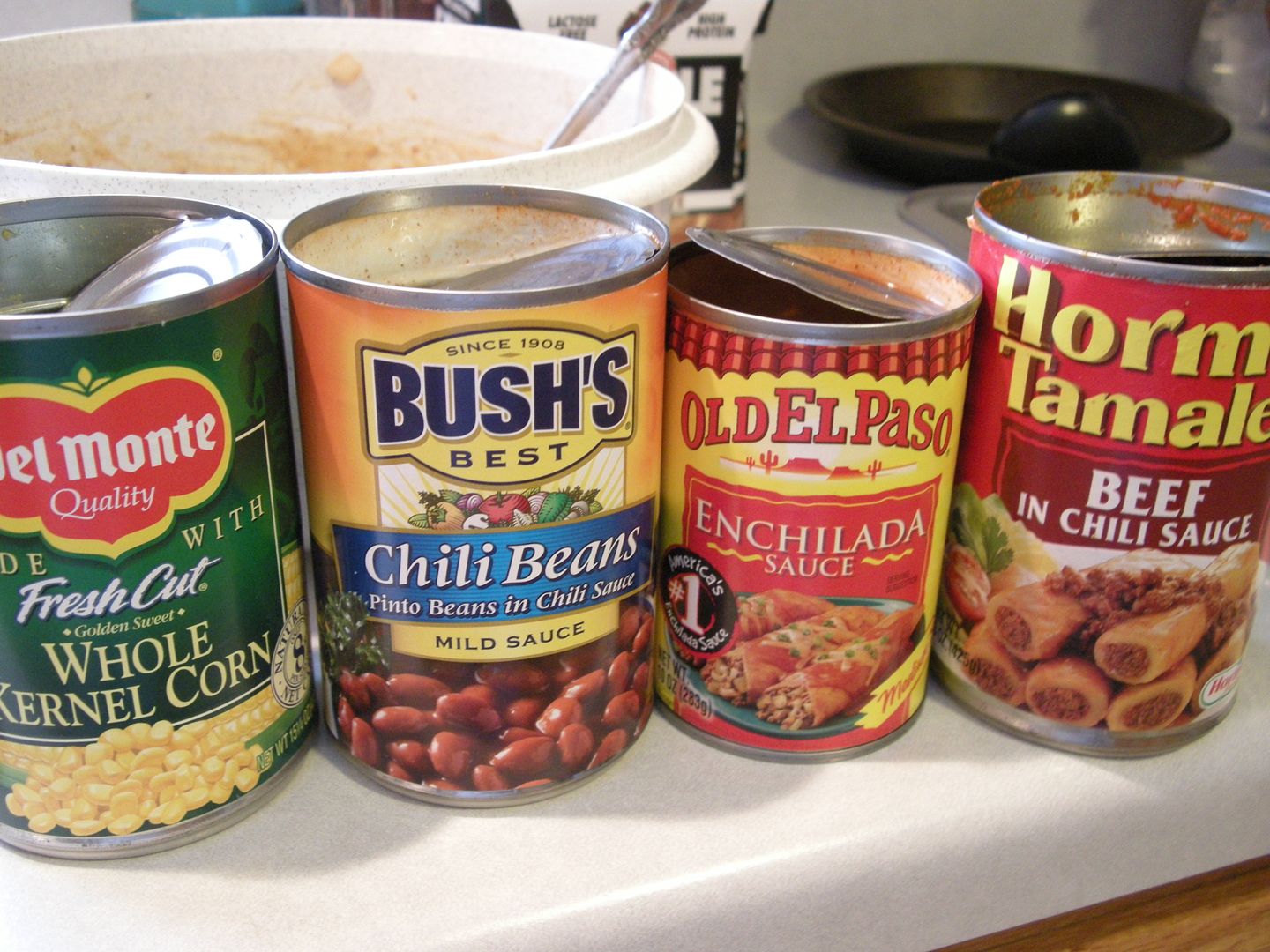 Â
Â
The first thing you do is start cooking a pound of hamburger with a small chopped onion. While that is cooking, open the tamales, peel them, and slice them into buttons to layer all over the bottom of a 13X9" pan. Pour the juice from the can over that, tilt around to even it out. Then get a big bowl out and dump in the drained corn, chili beans, and enchilada sauce, mix it real good. Then I stirred in a teaspoon of minced garlic from a jar and a half teaspoon of salt. I can't eat a lot of salt and spices, so at this point, another person might also want to add cumin, chili powder, or more salt to taste. And you should taste it, you could definitely over-spice or over-salt it since there is already sodium in all the cans, and plenty of spice in the beans. Finally, add a cup of shredded colby-jack and stir that in.
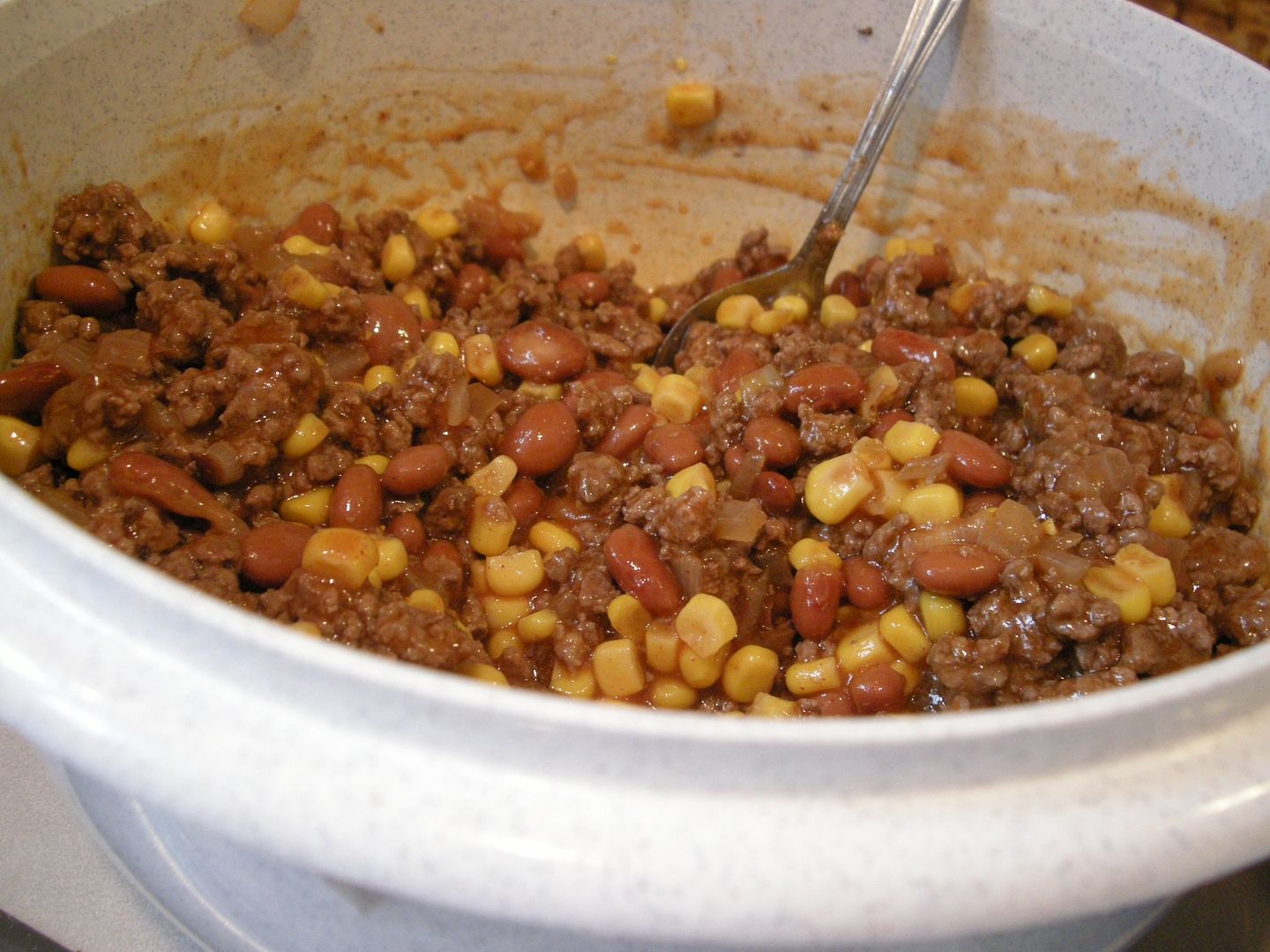
After the burger is cooked, I spoon it out onto paper towels and then pour it into the big bowl. I try to keep as much onion in there as possible. Stir all that in, then carefully spoon that mixture out over the sliced tamales and smooth it out. Put it into a 400 degree oven to start getting hot.
While that is getting hot, I mix up two boxes of corn muffin mix. If you make cornbread from scratch, I don't know how big your batch is, but two boxes of corn muffin mix is like two 8 or 9 inch square pans. I wanted more coverage than just one batch. However, the coverage is pretty thick. In the past I've had problems getting it cooked through after I spread it onto the casserole, but I've learned this trick since then- get the casserole hot *first* so the heat and steam coming off the casserole will help cook the batter underneath. So after the casserole has heated up a little for 15 to 20 minutes, pull it out and spread the cornbread batter over it. Put it back into the oven and let it get pretty done looking, then turn the oven off and let it sit in the oven to keep cooking the batter through without burning the top. It can sit in there another 15 to 20 minutes with no problems, and when you pull it out it's still pretty hot.
I decided to garnish like Mexican restaurants do, with fresh sour cream, avocado, and chopped tomatoes. This also really adds to the overall flavor, so it's going to be part of my recipe from now on.
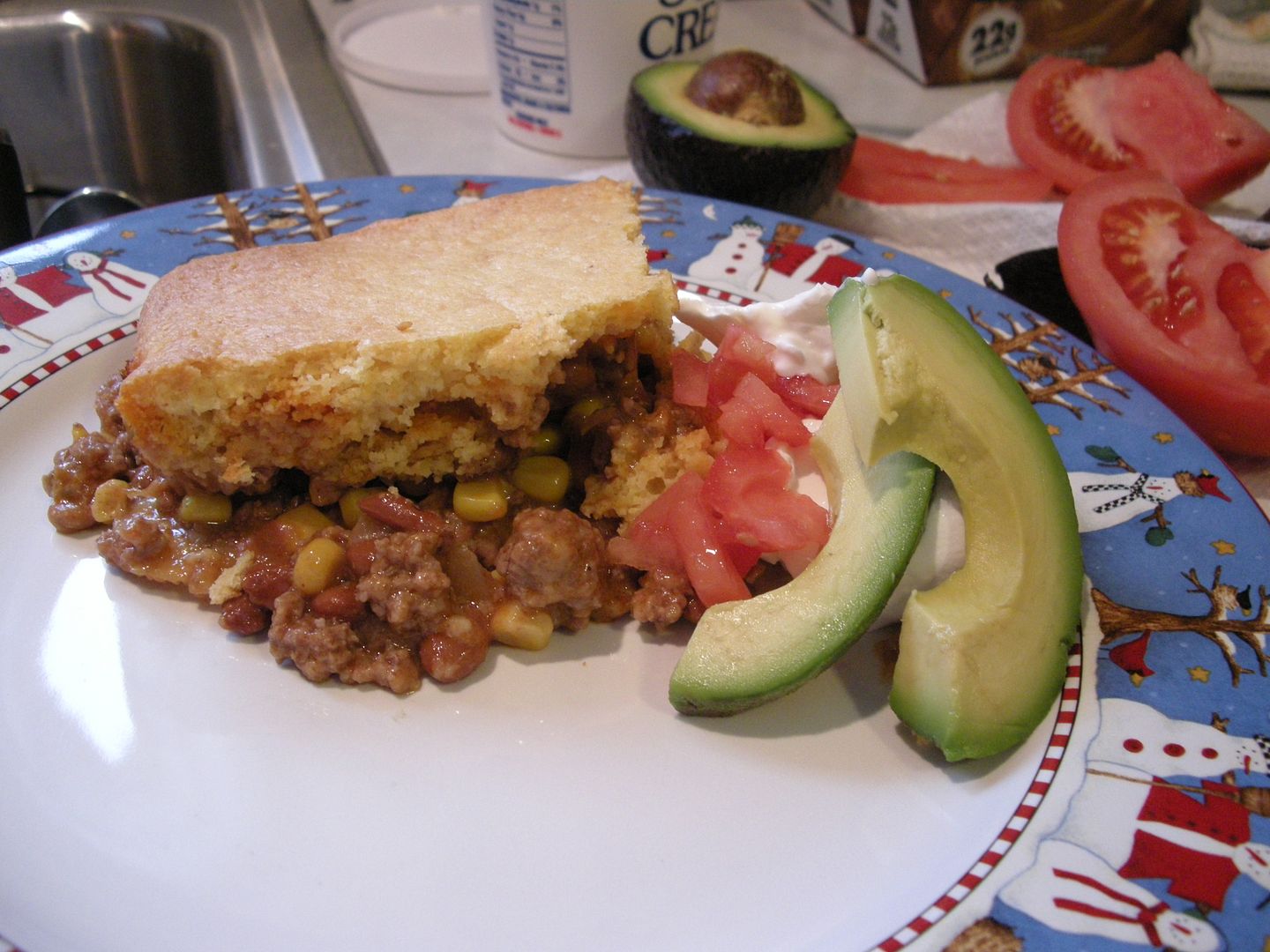
It pulls out of a nonstick pan very easily with a pancake turner. This held together really well, thanx to the little bit of cheese in there. If you're a big cheese eater, you could probably add more, but it might get way gooier.
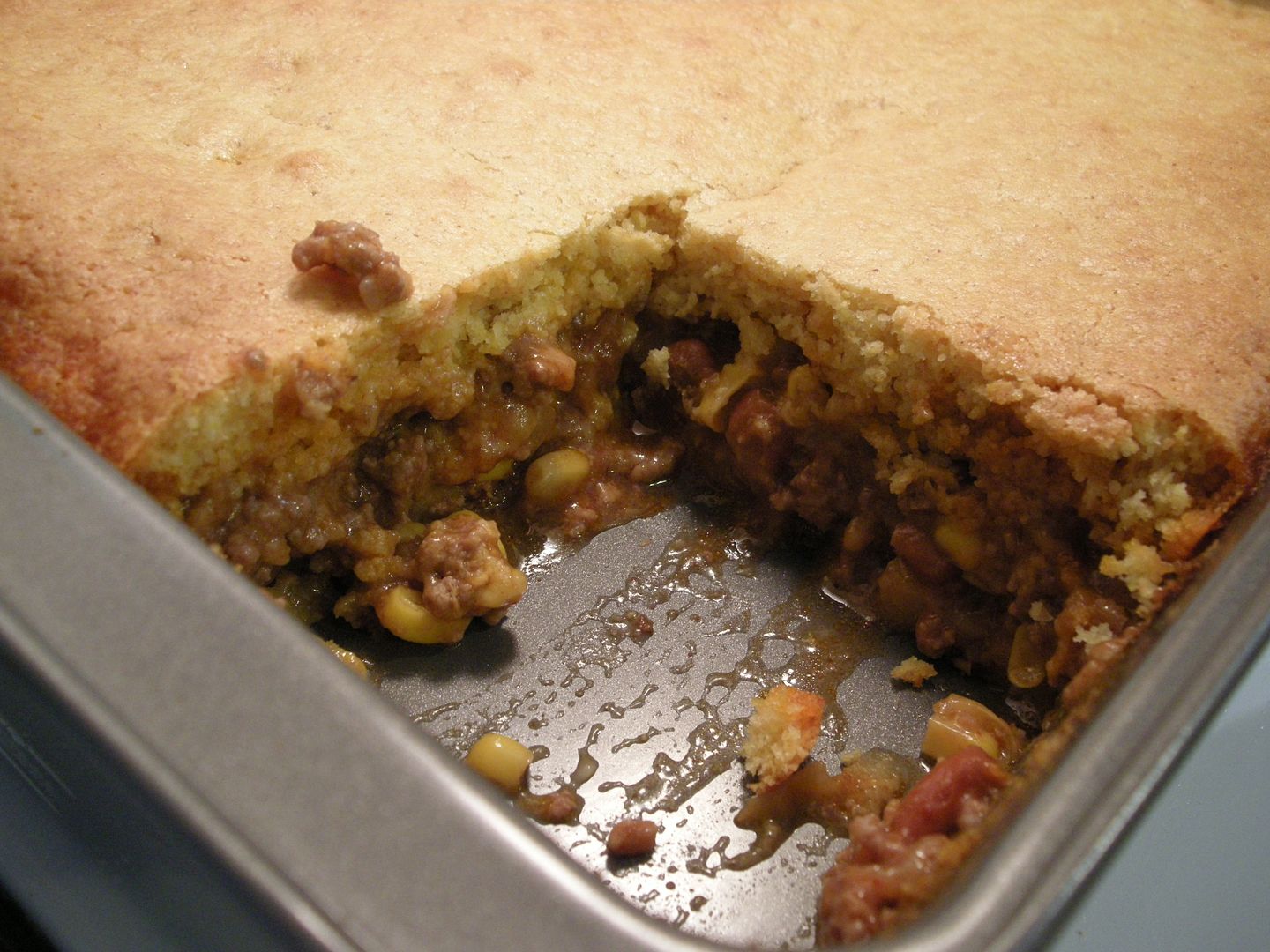
I mashed mine down to show off the inside. This is probably a super adaptable recipe, you could add anything imagineable or turn it into something Italian, etc. The cornbread mix I use adds a sweet touch to the spice flavor, nice balance.
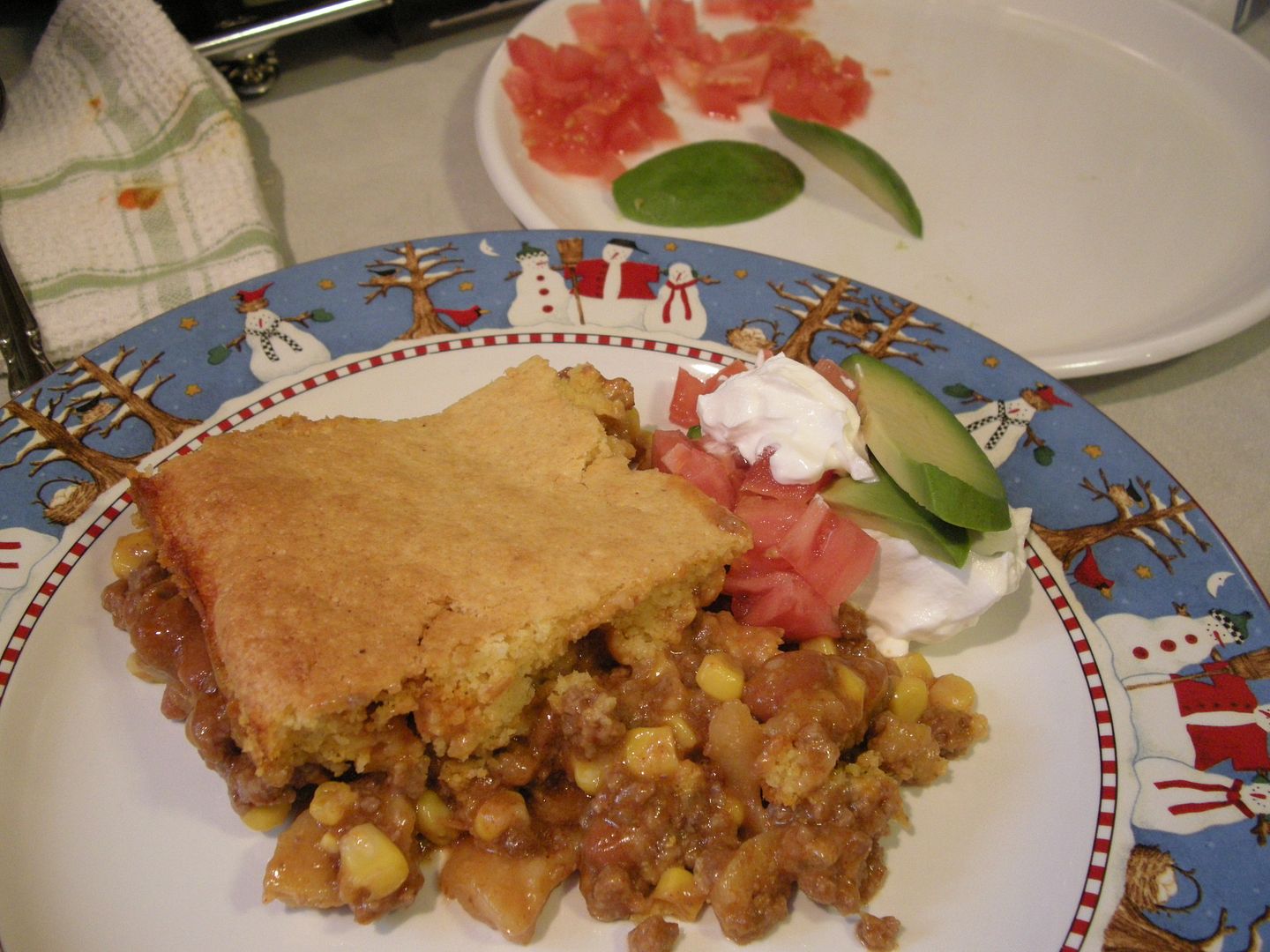
790: You're wasting your energy attempting to force my cooperation.
I have no sense of self-preservation and I can always be reassembled.

Comment
-
From 2-12-13
campfire scrambled eggs
I first ate this years ago during a big camping trip one weekend with probably over 50 girls plus a number of counselors. I was asked to go to be an extra supervisor for activities, which was fun. Smelling this breakfast cooking outside after sleeping in a tent is a gorgeous experience.
Start by frying up some bacon, set it aside. (If you prefer chopped up ham, by all means saute some ham at this step! Set it aside like you would the bacon.)
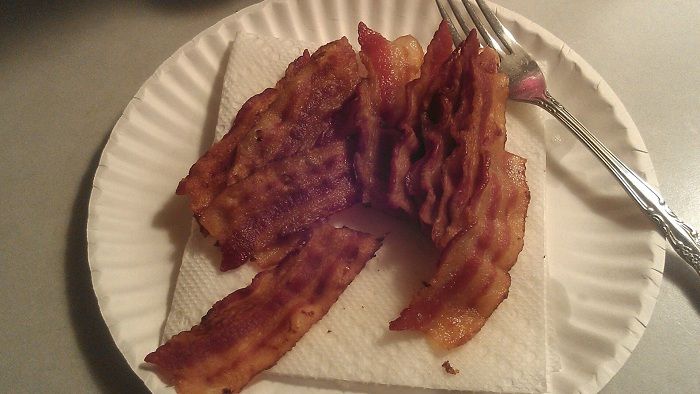
Drain the fat out of the pan, and I use 2 T of butter to every 2-3 eggs, so for this batch I used 4 T of butter. Let that melt on low heat in the pan while you chop up some veggies. I like green onions and orange bell peppers, very colorful in the eggs. My dad likes to steam broccoli florets in the microwave to add to his eggs (ew!), plus he sautes lots of chopped up jalapenos, other people like chopped tomatoes, pretty much anything your heart desires. The main thing is to get the harder veggies a little soft first before you scramble them in the eggs, so saute whatever you chop up in the butter (or whatever other fat you like to use, I think real butter has a nice flavor). I also like to add mushrooms, these are baby bellas.
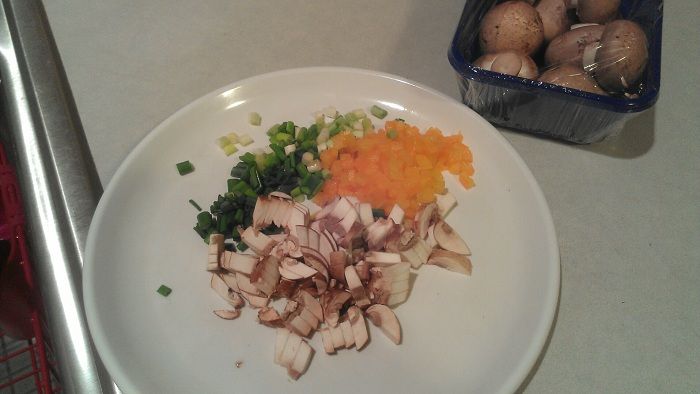
When the veggies reach the softness you prefer (try to keep some color, don't cook them to death), crumble the bacon up into the pan with the veggies and give it a good stir, then move all of it to the sides to make room for eggs. I grow my own eggs which are much more tasty than regular store eggs, and the yolks are darker.
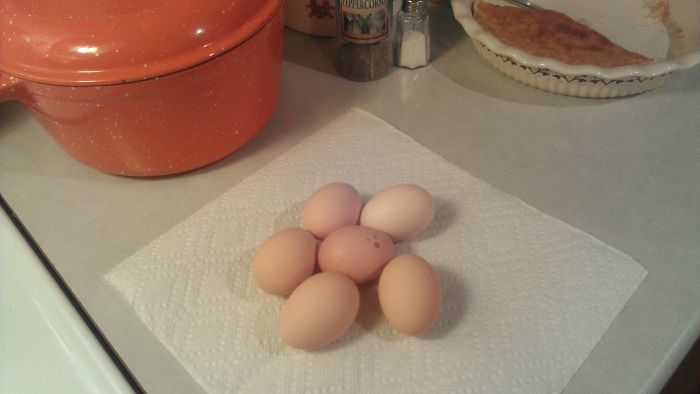
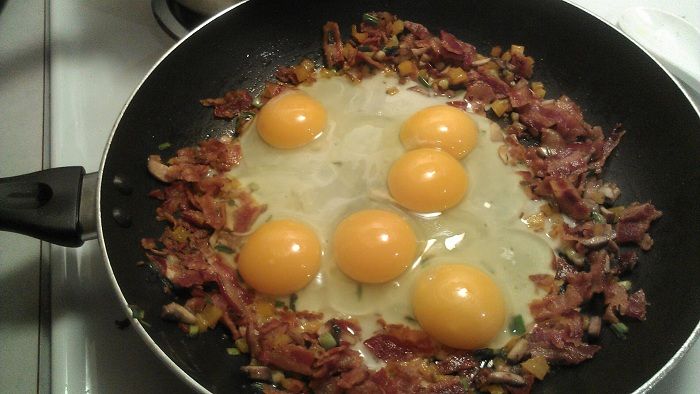
Pop the yolks with your spoon and stir the eggs up real good to scramble them, then pull the veggies and bacon into the scrambled eggs and make sure they're all scrambled together evenly.
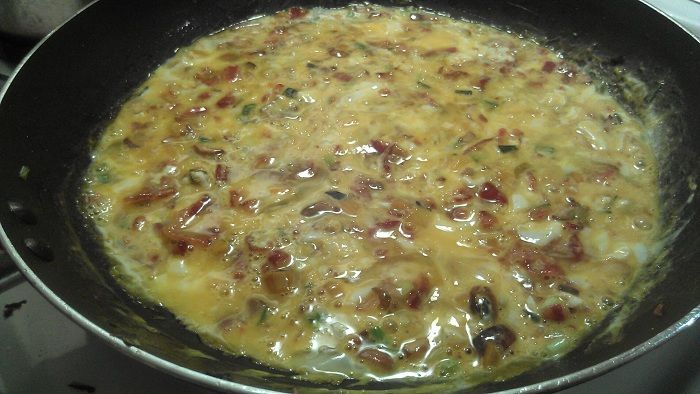
The rest is easy, just keep stirring every few seconds until the eggs cook and dry out a little.
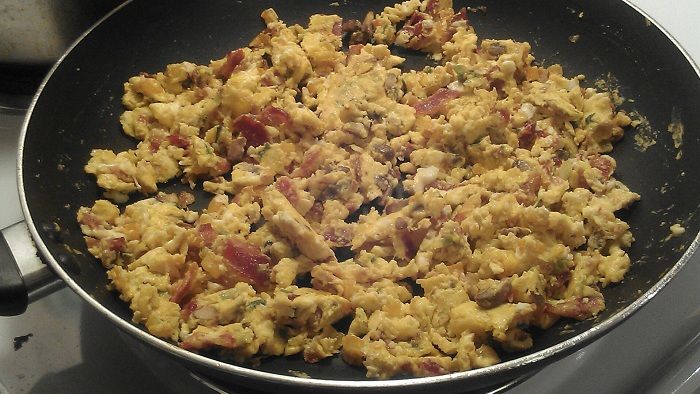
I turn the heat off when the eggs are just done and sprinkle cheese on. I like mixing several cheeses together, but mostly I like Swiss with a little parmesan. If you like a more Mexican style of eggs, the colby/jack is really good, and a little parmesan perks it up even more.

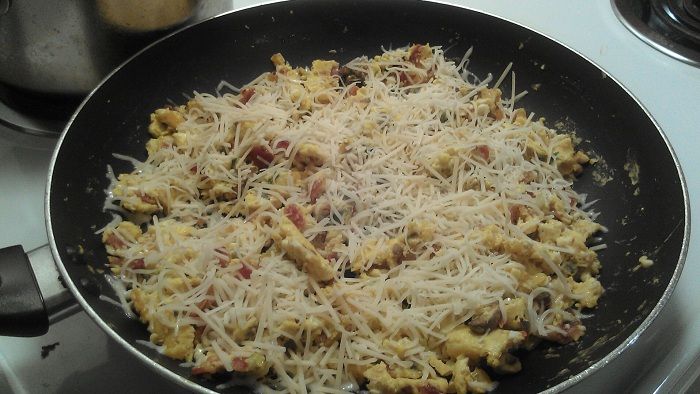
Looks great on the plate! Some restaurants offer options like hollandaise sauce or a dollop of sour cream or Tabasco sauce and maybe other goodies on the side, like sliced avocados and maybe more fresh chopped tomatoes or a separate mushroom sauce. This is the part where you play around with different flavors and styles. Me, I like digging in as soon as I can.
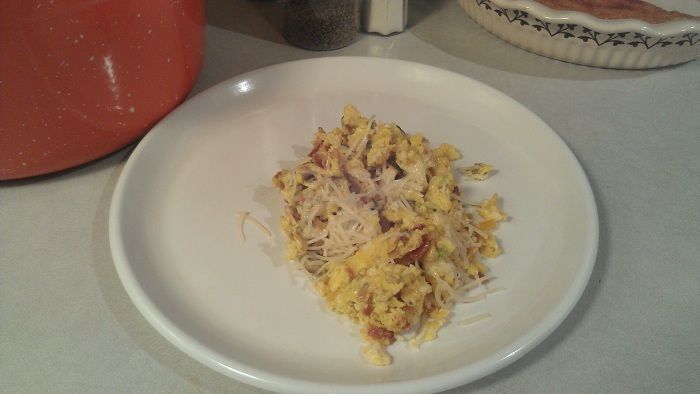
I like to make a big batch so I can save some for later. These scrambled eggs keep very well in the refrigerator for a couple of days, and Scott likes to take them to work, because he leaves so early in the morning.
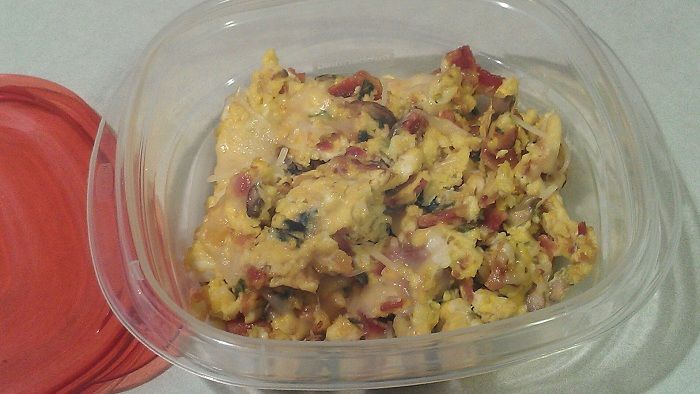
One very nice perk about this ~basic~ egg recipe is that it's very low carb and won't spike your blood sugar, if you're having to watch out for that. If you add toast, juice, milk, sauce, fruit, and other stuff like that you will, but not if you just stick to these eggs. Also please notice there is no added salt. You get plenty from the bacon (or ham) and cheese.790: You're wasting your energy attempting to force my cooperation.
I have no sense of self-preservation and I can always be reassembled.

Comment
-
From 2-21-13
diabetes and steroid meds
(this includes many food tips!)
Disclaimer- I am not a medical professional or nutritionist, but I do have diabetes and have become really good at controlling my blood sugar with diet since I cannot take the diabetes meds.
Having to deal with diabetes sucks bad enough, but sometimes you have to get prednisone shots or go on a medrol pack for allergies or autoimmune flare ups or goodness knows what else, and then diabetes can turn into a real nightmare. Steroid meds force your adrenal glands to squeeze out more cortisol, which in turn makes other hormones and chemicals do stuff, and while this can be wonderfully life-saving, it also makes your liver dump out its glucose backup, originally meant for fight or flight emergencies, into your bloodstream *right now*.
Facts About Corticosteroids (Steroids)
Steroid meds are awesome when we need them, even when they temporarily make us gain weight and lose sleep. But a diabetic person on steroid meds is in a catch-22 situation when their blood sugar spikes a hundred or more points and stays that way while on steroid treatment. Increasing your diabetes meds without strict monitoring can get dangerous, and then you wind up on a roller coaster between high spikes and low drops. This is especially dangerous in traffic. I have no proof of that, but I'm sure doctors and highway patrol would agree, because low blood sugar drastically affects decision making and reaction time, kind of like being drunk or sleepy.
I have a solution! And it works! I confess it's not my idea, bit it's brilliant, and I can help you.
The best thing I ever found for easily controlling blood sugar spikes during steroid treatment is the Rosedale Diet. (I'm not being paid to say this, and I bought nothing from them but a used book off Amazon.) Dr. Rosedale takes the time to list foods you can eat that don't spike your blood sugar. There are plenty of foods out there in the form of proteins and healthy fats that you can rely on. The problem is that our world nowadays is so saturated with carbohydrates (sugars and starches) that it seems almost impossible to know what to eat during times of illness and stress, when a diabetic's blood sugar goes the highest.
Other easy ways to learn what 'carbs' to avoid is by following the South Beach Diet or by learning the glycemic index. Even people without diabetes find they lose weight faster and in a more healthy way when they simply limit the amount of carbs they eat. Diabetes websites such as American Diabetes Association also recommend 'counting carbs'. But that sounds like a lot of work, you say. Nope, it's EASY. Food labels show you how many grams of carbohydrates per serving. Rule of thumb is 10-15 carbs or less per meal or snack. You get 11 carbs in one cup of milk, for instance (that's half of a tall glass).
I had the opportunity to try this myself recently after an ER trip with IV prednisone, benadryl, and pepcid for unknown cause that could have been anything from allergic reaction to lupus flare up. I also had to take a pain pill on an empty stomach there, so they gave me 4 crackers, which normally won't spike my blood sugar much at all because it's just under 10 carbs. Since I hadn't eaten in several hours, my blood sugar was most likely below 100 before I got the prednisone shot. (I'm able to control with diet since I can't take diabetes meds, and therefore test regularly, so I know pretty well how it goes for me.) After I went home I got my glucose monitor out and a piece of paper to keep track. My blood sugar had jumped up to 148 from only 4 crackers on an empty stomach. I knew better than to eat any more carbs that evening, so I scrambled a couple of eggs and ate a piece of cheese. My blood sugar held steady like that for about 12 hours. When it finally came down the next morning (tested 111), I had some coffee with a little milk and a half tsp. of sugar in it and did ok, but I still stuck to mostly proteins and healthy fats until I was sure it was going to stay down through the afternoon. THEN I went back to 10 carbs per meal and snack. But then when it was time to take prednisone pills that evening (24 hours after the shot), I stopped all carbs again about an hour before I took the pills and didn't eat anything else through the night. The next morning my blood sugar was down to 115, so I was able to handle a small amount of carbs with breakfast, and then eat normally as the day wore on.
This worked fantastically until the fourth evening. My brain fell out, I wasn't thinking, I remembered my prednisone and took it without waiting after I ate, and 30 minutes later suddenly decided to polish off the rest of some chocolate milk I had left over, about a cup. *WORST*NIGHT*EVER*. ~omg~ My blood sugar must have spiked over 250 and stayed there for hours, because I was miserable, up every hour to pee, tossing around feeling like my heart was beating too hard, felt too hot, finally got a nasty headache that went down into a neck spasm and I had to get an ice pack out at one in the morning just to be able to lay back down. It didn't even dawn on me until I woke up again at 3:15 with a nasty throbbing headache that I did that to myself. I totally forgot to count my carbs and slammed that prednisone down right in the middle of them. I took my blood sugar right then and it was 142, so at least it was on the way back down, and was 118 by 5:45, thank goodness. The next night I watched my carbs again and *slept great*.
Ideally, you want to keep your blood sugar below 120, preferably between 86 and 100. Blood sugar goes up and down all day as we eat, and that's normal, but it's not normal for it to go over 120 and stay way up there for hours, which is what prednisone will make it do, especially if you've just had a shot. So until that comes back down, NO CARBS, or you'll make it go way higher. A great site to get really good blood sugar information from another real person like me is Blood Sugar 101.
If you are diabetic and must spend a week or longer on steroid meds, here are a few quick rules of thumb until you can get your menu figured out-
*Avoid all sugared drinks, including soda pop, tea, and fruit juices.
*Cheese, cream cheese, and butter are ok, but cut down or avoid all other dairy, because lactose will spike your blood sugar, including cottage cheese and some other soft cheeses.
*Eggs, nuts, meats, poultry, and fish are awesome, but avoid eating them if they are breaded in any form, especially tempura. Breading (flour) will spike your blood sugar as much as sugar will. Peel the breading off. This goes for other breaded foods as well. NO onion rings or other breaded veggies like okra or mushrooms or jalapeno poppers! Also beware of sugared or honeyed nuts and main dishes with added sugar in any form, which happens in some Asian, Mexican, and Italian dishes. *note- IHOP uses pancake mix in their scrambled eggs and omelettes, which will spike your blood sugar. Check labels on frozen precooked meals.
*Avoid all grains in any form as much as possible until your blood sugar comes down, and then only in moderation because grains are super carby. This includes all pastries, cakes, cookies, pies, breads, buns, tortillas, gravies, sauces, pastas, and rice. I know this is really hard. *hug*
*Be very careful with all legumes. Beans will spike your blood sugar a little differently from grains, but will stay high for a long time if you eat a lot. This includes chick peas and tofu. This part is really tough for vegetarians who use legumes for protein, so please watch this and keep monitoring your glucose levels.
*Avoid potatoes and other high starch or high sugar root vegetables and gourds, such as squash, pumpkin, carrots, parsnips, and beets. Stick to leafy greens and cruciferous vegetables like broccoli, cauliflower, brussels sprouts, and radishes. NO french fries or chips! Corn is the worst, watch the peas, stick to green beans, unbreaded okra, and asparagus. *note- some restaurants soak lettuce and salad veggies in sugar water to freshen them up, which can spike your blood sugar. This has happened to me. It sucked. It's not fair when you can't count on 'healthy' low carb foods in restaurants because of poor practices, so be vigilant.
*Be careful with tomatoes and ketchup, very high in both natural and added sugar content. Avoid salsas, spaghetti and pizza sauces, basically stay away from concentrated tomato products if your blood sugar is already high.
*Cut out fruits until your blood sugar is under control, although you can probably eat most berries without much of a problem. NO watermelon! Fruits are naturally very high in sugar content and are as bad on spiking blood sugar during steroid meds as drinking soda pop. I think avocados are ok, half a banana or less, but since fruits aren't marked for carbs and are generally carb rich, it's easier to walk away if you haven't had the time to look it up.
DO NOT DESPAIR. Remind yourself this is temporary until you can figure out your blood sugar pattern, like I did, or until you can make sure your diabetes medication is working well for you while you are on steroid meds. The worst thing you can do on top of feeling sick or dealing with something like flare ups and meds is make your diabetes worse. When you don't feel well in the first place, it's very natural to grab and eat something that tricks your body into thinking it will feel better, like caffeine or quick sugars and starches. But that feeling is very temporary, and the consequences are not only miserating, but harmful and even dangerous if your blood sugar is spiking up into the 300's. YOU CAN CONTROL THIS. I've learned this because my own health depends on it, since I can't take the pills. A nice perk I've noticed is that when I carb count while on steroid meds, I don't have any new weight gain.
I'm not going to abandon you there. I have a lot of experience with making food yummy and keeping my blood sugar down. That list up there is for emergencies while you are trying to get through the next 24 hours (or week) of misery (because that is usually when I find articles like this myself, and probably why you are here, too). You need a reward for sticking through this far during such a sucky time! Let's make this easy!!!
I know what you're thinking- it's already sucking bad enough, but the thought of eating salad and no dessert when you need comfort food the most is about to send you through a black well of despair. If you absolutely must have something or go crazy, the dessert I have found that does the least harm is a very simple cheesecake, but you still need to keep the portion small so you won't make yourself sick. I got this recipe from a Philadelphia cream cheese box. Total carbs in the entire cheesecake is 224, and if you slice into 8 portions, each portion is 28. So eat half a slice of this cheesecake and get only 16 carbs, which is fantastic compared to most desserts having 30 or much more.
Crust- 1 1/4 graham cracker crumbs, 1/4 c sugar, 1/3 cup melted butter, stirred together and patted into pie plate.
Filling- Mix together 2 8-oz blocks of cream cheese, 1/2 c sugar and 1 tsp vanilla, then mix in two eggs. Pour into crust and bake at 350 for 35-40 minutes. Do NOT add a topping when it's done unless a label says it has no carbs because it's been replaced with artificial sweeteners. Fresh berries are ok if you don't add sugar to them, but please use your glucose meter to verify this and not my word.
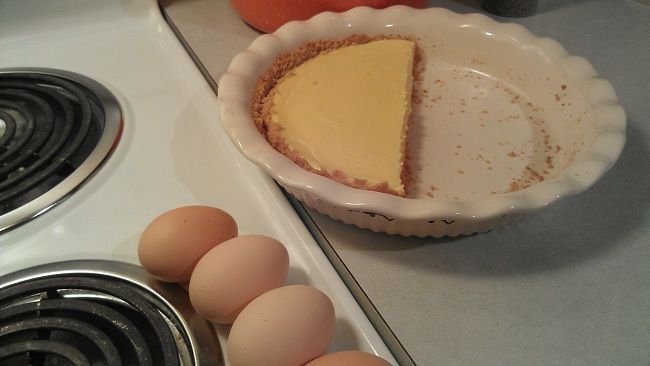
One of the biggest challenges in switching to a low carb diet is thinking you have to sacrifice flavor and feeling comfortably full, if you are used to filling up the empty corners on breads and desserts. One of the myths of good health is that fats will kill you, when in fact the sugar is already doing it much faster. The body craves healthy fats because they are essential to good nerve conduction and proper metabolism, among many other things. Because fats have lots of flavor and calories, a little bit of fat replaces a whole lot of sugar and starch and your body is much more quickly satisfied when you eat them. When you eat sugars and starches and play the game of spiking your blood sugar, your body sends out an alarm when your blood sugar starts to drop, and if you are diabetic, this alarm is sent out prematurely because your system is wonky, and bing, you're hungry again even when you've had more calories than you need and it hasn't been that long since you've eaten. This vicious cycle can be broken without the horrible suffering you imagine, simply by eating more proteins and fats. Treat yourself to some delicious food as you limit your carbs while you are on steroid meds, and you will feel so much better in both the short and long term. I have a few recipes of my own linked right here that work wonderfully for me.
campfire scrambled eggs- add more veggies if you like, it only gets more delicious
restaurant quality alfredo sauce- if you need a low carb sauce or gravy to go over grilled meat or poultry (do not add pasta)
Italian Chicken Fingers- the breading is half parmesan cheese for low carb
really good chicken soup- super low carb unless you add carby stuff like potatoes and rice
I wish you all the best, and I hope this was helpful.
790: You're wasting your energy attempting to force my cooperation.
I have no sense of self-preservation and I can always be reassembled.

Comment
-
From 3-26-13
Old Fashioned Chicken Stock
I've seen several food shows that demonstrate how to make homemade chicken stock. While chicken stock has been a staple around the world for time out of mind, it's still not the easy breeze a 30 minute TV show can make it seem. I've been doing this for years, and I'd like to fill in a few holes for first timers. This is going to be a lengthy recipe post with 19 pictures, and some think "overkill" while others weep with relief. THIS is how you make a really good old fashioned chicken stock.
Mine starts with a ceramic glazed cast iron stock pot that I ordered from Ginny's. (NOT being paid to link that. I just really like this pot.) Best pot ever for super slow simmering. The heat distributes well, and you don't get hot spots like you do with metal pots. If you prefer metal, try to use the thickest heaviest pot you can find so you can control the simmer not running away into a rolling boil on low heat over 2-3 hours.
If this is your first time, the first thing you do is schedule this adventure for a day where you're not stressing against a time crunch. Do NOT plan the next meal around this, it's too much work until you get used to it. People in the old days didn't have technology and hectic lives, or this might never have been invented. I know, nothing like giving you a recipe that is arduous and time consuming, but it's THE BEST chicken stock you ever tasted in your life. All your other recipes using chicken stock will benefit.
I like using Smart Chicken. It's a little more expensive, but looks and smells almost as fresh as a farm chicken I butchered myself and froze back. Whatever chicken you buy, make sure it fits into the pot comfortably. I've made mini versions of this with a cornish hen in a large saucepan, whatever takes your fancy. If you don't have a whole chicken, use a bunch of chicken pieces with the bones still in, wings and legs are good for this. Part of the flavor comes from the skin, fat, and bones, not just the meat.
Rinse your chicken very thoroughly under lukewarm running water, inspecting it carefully for wax (looks yellow), pinfeathers, giblets and/or neck hidden in the inner cavity, etc. Be careful of broken rib and backbones if you reach inside. (If you do cut yourself on a bone, stop immediately and wash your hands with soap and water and cover the wound before you continue. Getting an infection in your skin from raw meat sucks, and getting your blood all over other people's food is gross.) I like to pull out the stringy goop and cut off the tail and the big wad of excess skin on both sides of the open cavity. After rinsing, place the chicken directly into the pot. Throw away all the extra stuff not going into the pot, and wash your hands and the sink with soap. I wash my hands a second time just to be sure. I grew up on a farm, and we didn't know back then about raw meats and cross contamination. I threw up a LOT. Be smart and save yourself a bad tummy ache later.
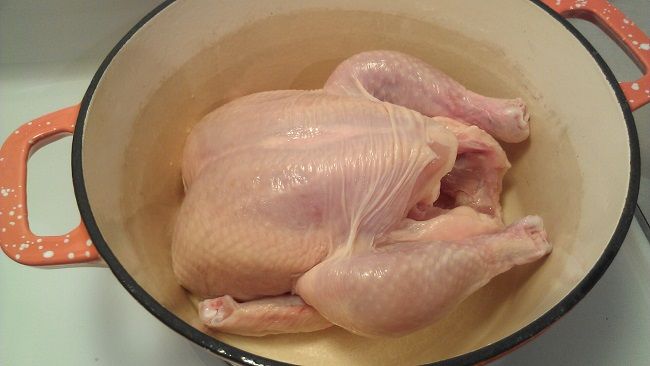
After that is all cleaned up, it's time to prep veggies. Use a fresh knife, not the chicken knife. Make it a habit to use different utensils for meats and veggies, even if you know it will all be cooked together. Why? Because, in this instance, you only want half of a large onion and 2-3 stalks of celery. Don't contaminate what you don't use right away with a meat knife. You'll also want a couple of large carrots, peeled and cut in half. I like stuffing carrot and celery inside the chicken. Wash your hands immediately after touching the chicken again. Put the rest of the veggies into the pot.
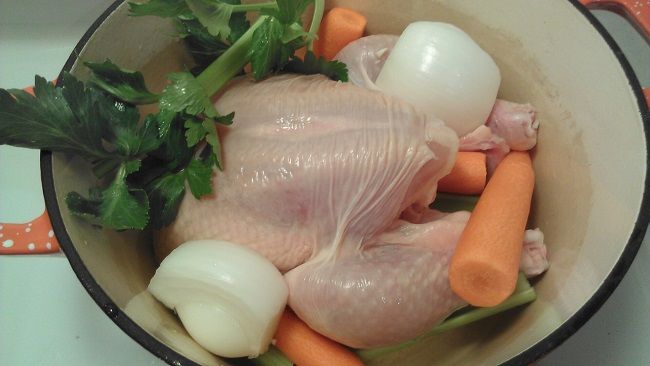
I use 9 flavoring ingredients in my stock-
1 t. salt
4-5 peppercorns
1-2 bay leaf
1 T each of rosemary, thyme, basil, parsley, and oregano
1/2 t. garlic powder
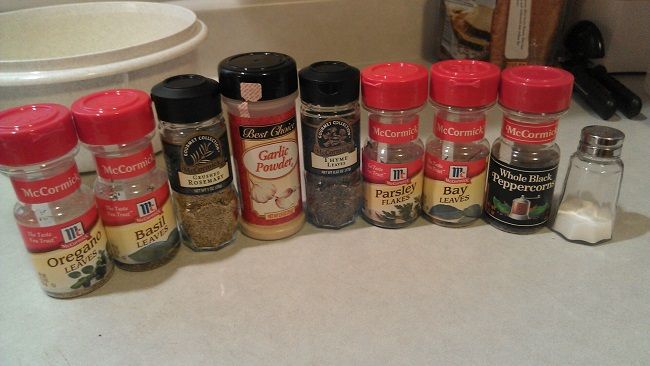
On TV shows they tie these up into sprigs and/or a little bag. Making chicken stock is a lot like making tea. Steeping the loose leaf herbs slowly with plenty of room for them to circulate and swell brings such a beautiful aroma and flavor that tying it all into a little bag seems like a crime. Doing that doesn't really save you any time or work later, because you still have to strain the stock when you're done anyway, right? May as well go for gold.
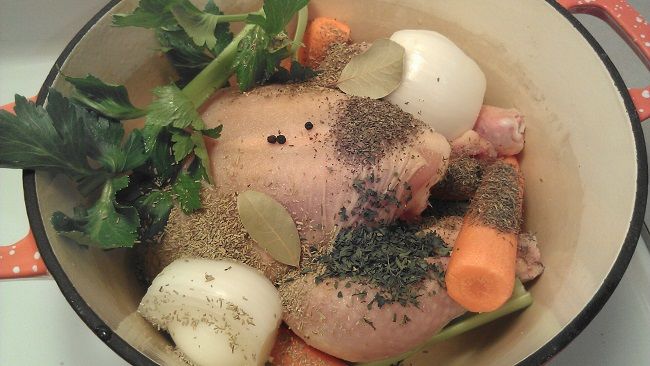
When all your ingredients are assembled into the pot, pour water over it all up to 1-2 inches from the top. You want to leave some room in case you walk off and it boils, which I've done on more impatient days. You'll also need splash room, which I'll get to in a minute.
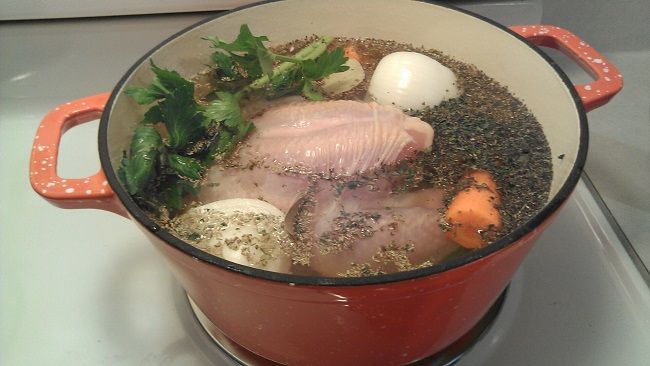
Put the lid on and turn the burner on low. Trust me. If your chicken was already thawed, 3 hours will be about right on low. If it was frozen solid, give it 4-5 hours, but still keep it on low. If you are using chicken pieces instead of a whole chicken, or cooking a cornish hen in a smaller pot, maybe two hours is good. You'll get the hang of it.
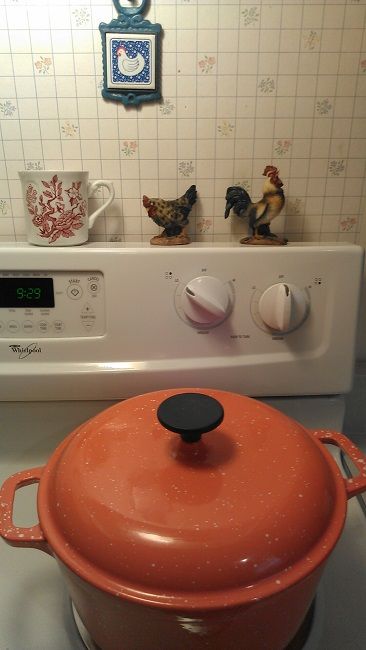
About halfway through the cooking time, one to one and a half hours for the big chicken, you'll want to turn it over. It will cook through just fine without turning it over if you leave the lid on, but turning it gives all the meat steeping time in the stock for flavor and juiciness. Some of my biggest messes have happened while I'm turning a hot chicken over in a scalding stock bath, so be careful about burns. If you do get scalded, immediately get ice or at least cold running water onto the burn before it blisters. Your skin will literally cook from that high temp, and you must cool it quickly so it will stop the cooking. Heat denatures protein, breaks the molecular bonds, and the ice or cold water will stop that process. Never ignore a burn, even if it doesn't hurt that bad. It will hurt bad later when your nerves recover from being cooked alive.
Here's a good way to turn a chicken. Use a long handled heavy gauge slotted spoon and a very long fork, one in each hand. Guide the fork into the inner cavity while you brace the chicken with the spoon. When you have the fork inserted well enough to move the chicken, lift slightly (lifting higher creates a bigger splash if the chicken slips), and turn like a spit while you use the spoon to help maneuver it on over. Resist the urge to stand real close to the pot for better leverage or bracing or whatever, that is a mistake and you could wind up having to change your clothes and ice your chest and stomach. (Twenty years of experience...) Once the chicken is turned enough to go on over, use the spoon to ease it on down. Put the lid back on and walk away again.
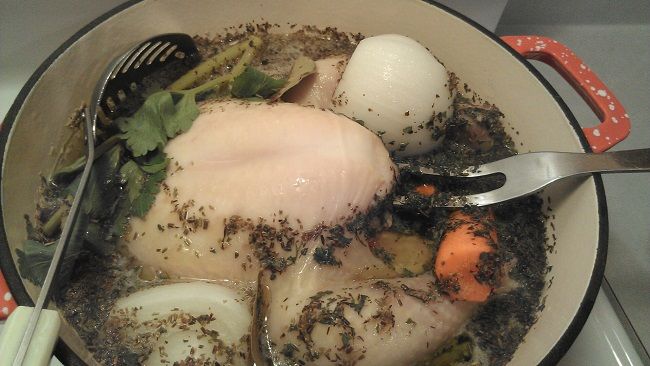
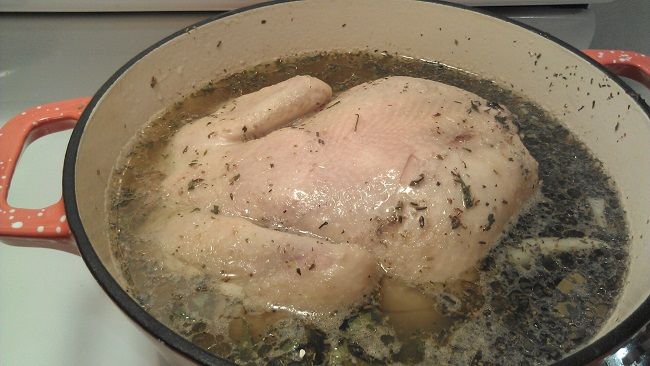
Your chicken will be cooked through soon after, but it's not 'done' until it easily comes apart when you press the spoon down into the mid back. When you've reached this stage, turn off the burner and let your stock rest with the lid on. You can take the chicken and veggies out now if you want, or you can let them cool a little in the stock. It will all stay hot for a good hour because the heavy pot is so efficient at holding the heat in.
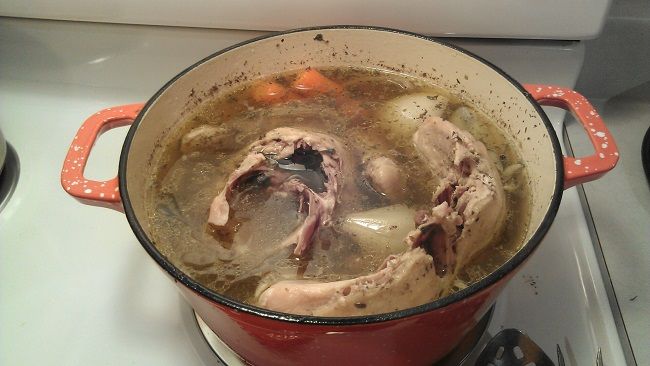
After an hour, you need to go ahead and get the chicken out onto a plate. It'll still be pretty warm, but you can cover it in plastic wrap at this point to hold in the moisture and cool on the counter for half an hour. Never put hot food into the refrigerator. Hot food can shatter glass shelves in the fridge, and can encourage mold growth in foods it touches or sits near, because they'll become less cool being next to something hot and can take too long to cool back down again. Since your chicken just came from a long simmer, it is sterile coming out of the pot and won't spoil while it's cooling down on the counter, but don't leave it out longer than a couple of hours. When it is cool enough to comfortably handle, I put the chicken into a gallon storage bag into the fridge to deal with later.
Strain the veggies out of the stock into a bowl using a slotted spoon, and keep spooning through until you're pretty sure you've gotten the bay leaf and all the stray layers of onion that have floated off. Throw all that away. It might be tempting to think you can use it later somehow, but trust me, it's not worth it. The flavor and nutrition have steeped out of the veggies into the stock, they've done their duty. Throw them away.
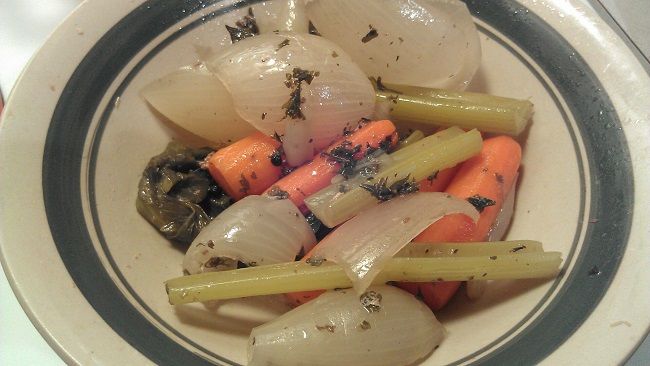 Â
Â
Straining stock isn't hard. Some recipes say to strain through cheesecloth, which is expensive and way messier than this needs to be. Unless you are hoping to make a clear consume or broth, you just don't need that extra stress. I use a large mesh strainer with a handle so it will sit over a bowl. I set the bowl in the sink so I don't have to clean up what I spill, and from there it's a matter of tipping the stock pot just right so all the liquid goes through the strainer. Then I carry the strainer to the trash, clap the crap out, and immediately wash it with soap so I don't have to mess with it later. The faster you get that strainer cleaned up, the less you'll hate straining stock. If you leave that strainer sitting around until the chicken fat hardens and the herbs dry, it will be impossible to clean and you'll never make chicken stock from scratch again.
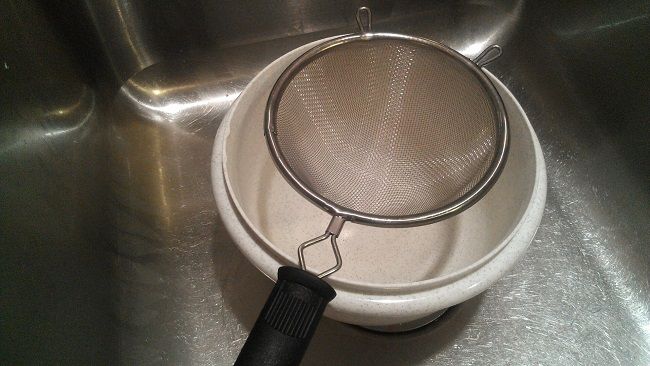
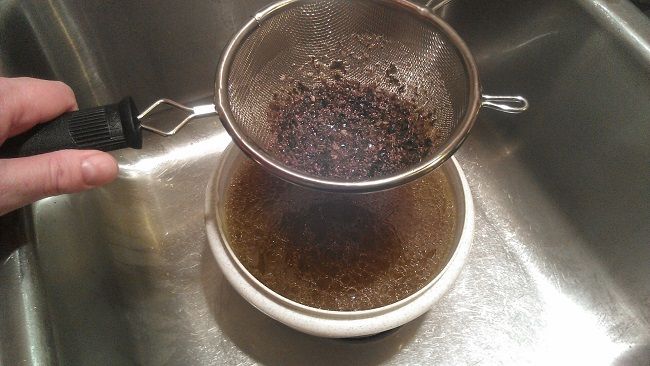
I really like using tupperware for that stock, put a lid right on it and set it into the fridge. You can leave it alone there up to 3 days, but after that you either need to cook with it or freeze it back. Stock spoils faster than just about any food on the planet. If you open it and it has spoiled, you can't salvage it. Throw it out because it will only poison you now, no matter what you do. You can kill germs with heat, but mold is a molecular structure that can survive heat and wreak havoc in your body. (Grain molds can cause brain damage if bread is made from moldy grain. Don't cook mold!!!!)
All the fat in the stock floats to the top, and in the fridge it hardens into a skim on top, which is very easy to remove while it's still cold. Use a spoon to skim it off and throw it away. What's left is technically an aspic and wiggles like Jello. It melts right back into stock as soon as you heat it up, and it's now ready to go into your recipes. You can measure it out by the cup and freeze in ziplock bags. I froze this batch into a quart bag to use in stuffing next Thanksgiving.
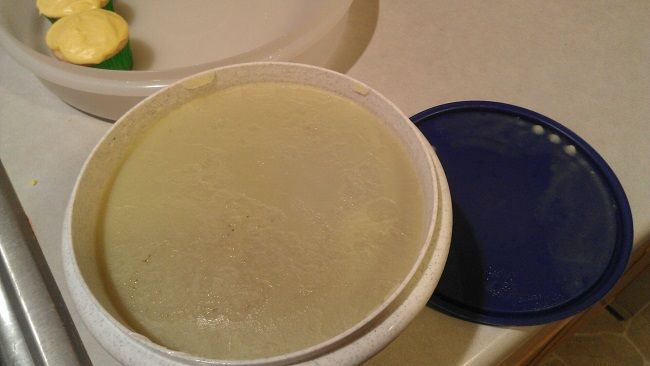
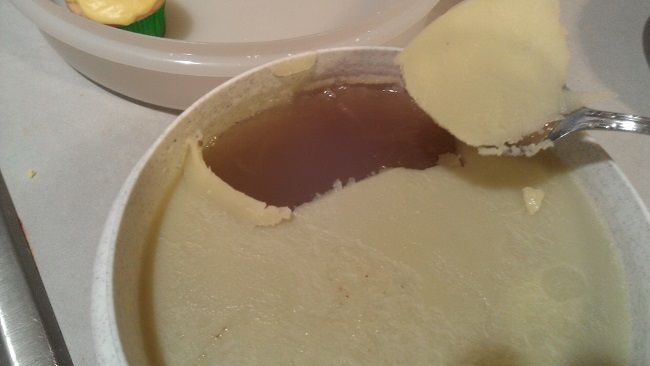
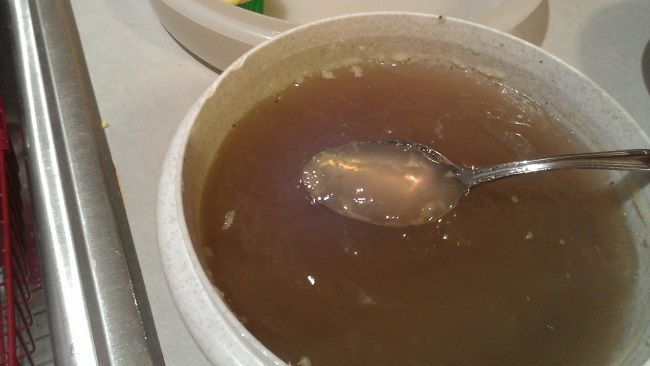
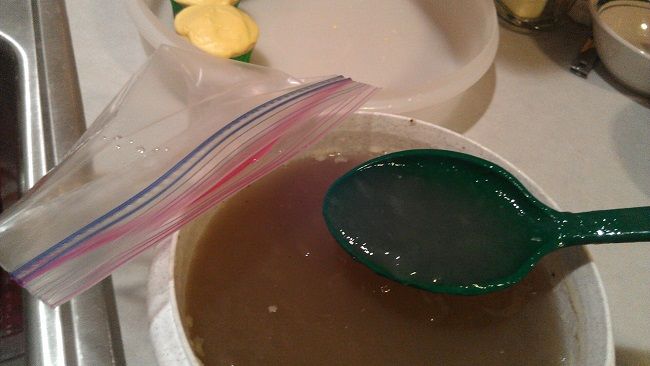
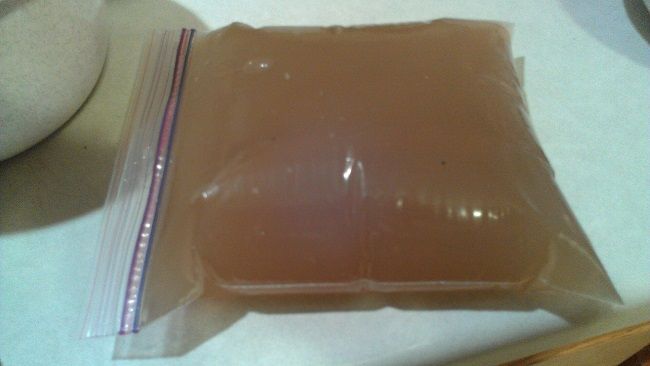
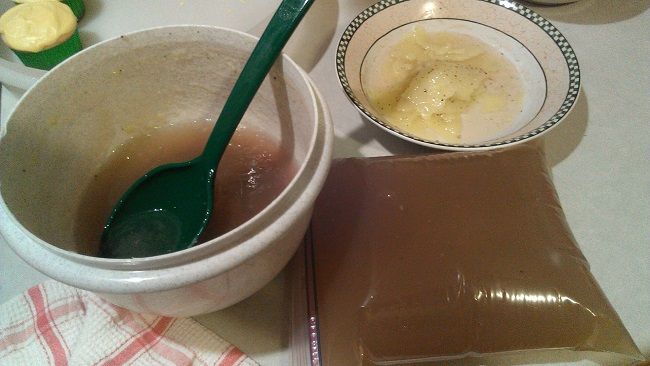
The rest of the herbs that got through the strainer all settle at the bottom of the aspic, and will stay there as long as you don't tip the bowl or disturb it as you ladle the stock into bags. When I get down to that stuff, I just pour the dregs down the sink and flush a little water after it. With the fat and other solids removed, this small amount won't cause a clog.
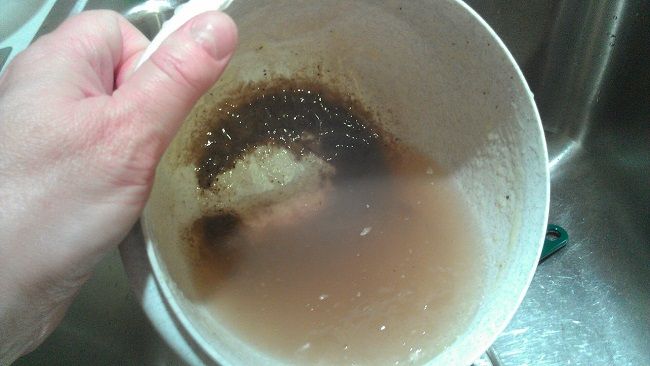
790: You're wasting your energy attempting to force my cooperation.
I have no sense of self-preservation and I can always be reassembled.

Comment
-
From 5-21-13
Stargate Pie
I've got a bit of a meringue obsession going this year, since I've had so many eggs coming in from the new hens. Organic eggs around here easily cost $6 a dozen, and at first I hoarded my eggs like gold, but after they piled up and took over the refrigerator last fall, I found lots of ways to play with them. We don't eat a lot of sweets in this house, but we do like chocolate pie. There is only one cup of sugar in the whole pie, and meringue is really good for protein, so why not? About once a month I have a little fun with it.
This post isn't about chocolate pie itself, but in case it makes you hungry for one, here's the recipe I use. I just buy premade piecrust, cook and cool it ahead of time. The pie part is a very thick pudding, for which I use a stainless steel saucepan and a wooden spoon. It's quick and easy, but you can mess it up. I've thrown out puddings and started over a few times because I'm so easy to distract, but it's a cinch to start over.
First thing you do after you bake the crust is separate your eggs, yolks into a small bowl, whites into a bigger bowl to use with a mixer. Be prepared to waste a few eggs if you're not very good at separating eggs, perhaps keep a third bowl nearby for scrambled eggs later. I like using my hands, and it's messy, so put paper towel down on the counter to set the shells on and hold the drippies at bay, scoops up so easy when you're done. Cream pie recipes call for different amounts of eggs, this one originally only called for 3, but I find it holds better with 5, and also bumps up the protein value in your pie. Try not to get any yolk in the whites bowl, and keep the yolk bowl as free of whites as possible. If a yolk breaks and everything goes wrong, that's what your third bowl is for if you can't bear to throw away eggs, you can use those later for breakfast.
In your saucepan put 1 cup of sugar, 1/3 cup of flour, 4 T of cocoa, and 1/4 t salt, stir all that up till it looks sifted. Slowly stir in 1 cup of milk, doesn't have to be perfect, just make sure it's all wet and there aren't any big dry lumps lurking at the bottom. Turn the heat on medium. This bit is important. Don't go higher than medium (tempting if you feel impatient) because milk scalds so easily. Stir, keep stirring, keep the bottom from turning into a super thick sludge while the top stays runny. The key is to keep it all the same consistency while it cooks, keep the thickening up as homogenized as possible.
It really doesn't take long for that to thicken up and start to 'glop' in a weird thick 'boil', at which point remove it from the heat and keep stirring for another 30 seconds till it settles down so it doesn't burn at the bottom. I'm right handed, so with a fork over my yolk bowl on my right and the spoon over the pudding pan on my left, I drizzle little bits of pudding into the yolks while I quickly whisk them with the fork. It's like walking and chewing gum at the same time, you get the hang of it. You have to keep the yolks moving so they don't have a chance to 'cook' and lump up like scrambled eggs. Heat denatures protein, breaks the molecular bonds and makes them change shape and get stiffer, so to keep the yolks more liquidy, keep them moving. All the chefs on the food channels will tell you this is tempering the yolks, and that only means bringing up the heat slowly so you can control their texture, so next time you hear that word, you'll know what it means. Whisk in several spoonfuls of the pudding till the yolks are all chocolaty looking, then pour the bowl of eggs into the pudding pan while stirring quickly with the wooden spoon. If you get egg lumps, either get them out or throw this all away and start over. Cream pie with scrambled egg lump texture is kinda gross.
Put the pan back on the heat and keep stirring. The gloppy boil will happen a lot faster this time, and you don't want it happening very long at all, just make sure it gets good and hot for about a minute or so while you stir, then take it back off the heat and stir in a T of butter and a splash of vanilla. Pour it all into the baked pie crust and set aside.
All this just to get to the meringue.
Meringue is very temperamental, especially if you live in an area that is the least bit humid, but so what, it's still fun to eat and pretty on a pie. They say meringue works best if the whites are room temperature to start, but I haven't found any difference. Most recipes call for 1/4 t of cream of tartar in the whites before you start mixing, some use a dash of vinegar, some don't use either, but if you want to delve into experimentation- How to make the perfect meringue | Life and style | guardian.co.uk But back to having fun! I use cream of tartar, I think it's more reliable and doesn't make it taste funny. Also I splash in a little vanilla, yum! So 5 egg whites, 1/4 t cream of tarter, 1 t vanilla, and set your mixer on a pretty decent speed. You'll be standing there a few minutes, and it will seem like forever because you're not doing anything else, but it still goes fairly quickly. Since I've been playing with meringue so much, I also add food coloring gel at the start, this time I squirted a gob of blue gel in. For those of you who have never made meringue, the rest is in pictures so you'll know you're not epic failing if you don't get that pretty fluff right away. Most recipes don't mention the nerves you get wondering if you're doing it right when it doesn't look at all like a picture in a book.
Starting out it looks kinda like jello, doesn't it? When you don't put food coloring in, you still get this pretty froth going, that that is what you watch, the froth. It changes as you go, and once you've done this a few times, you can get pretty good at gauging how far into the whipping process you are as the froth changes. Right here it's very liquidy.
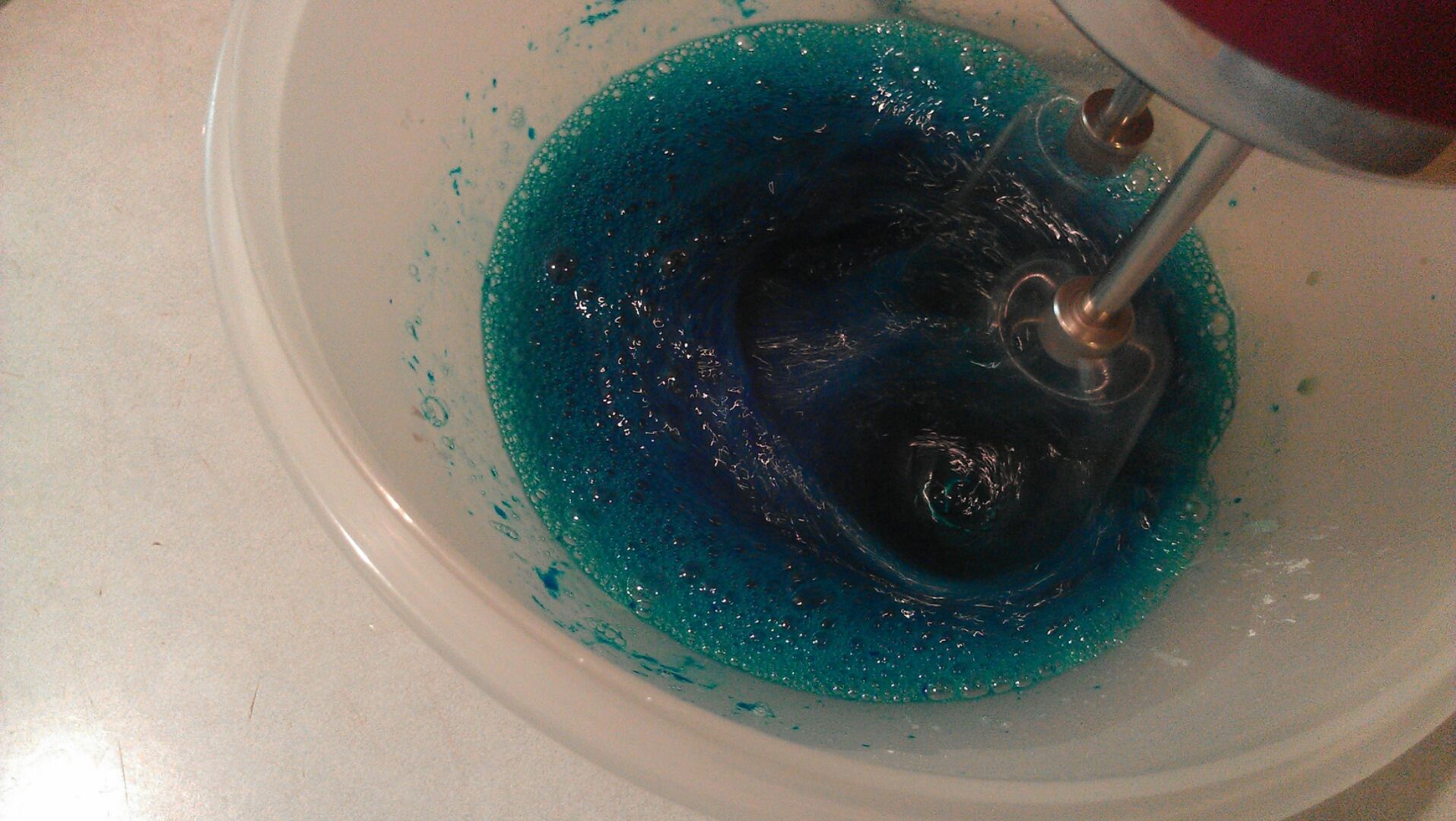
It doesn't take long to look very bubbly, the way coke does when you first pour it into a glass over ice. As you work more air into the froth, the color will lighten up.
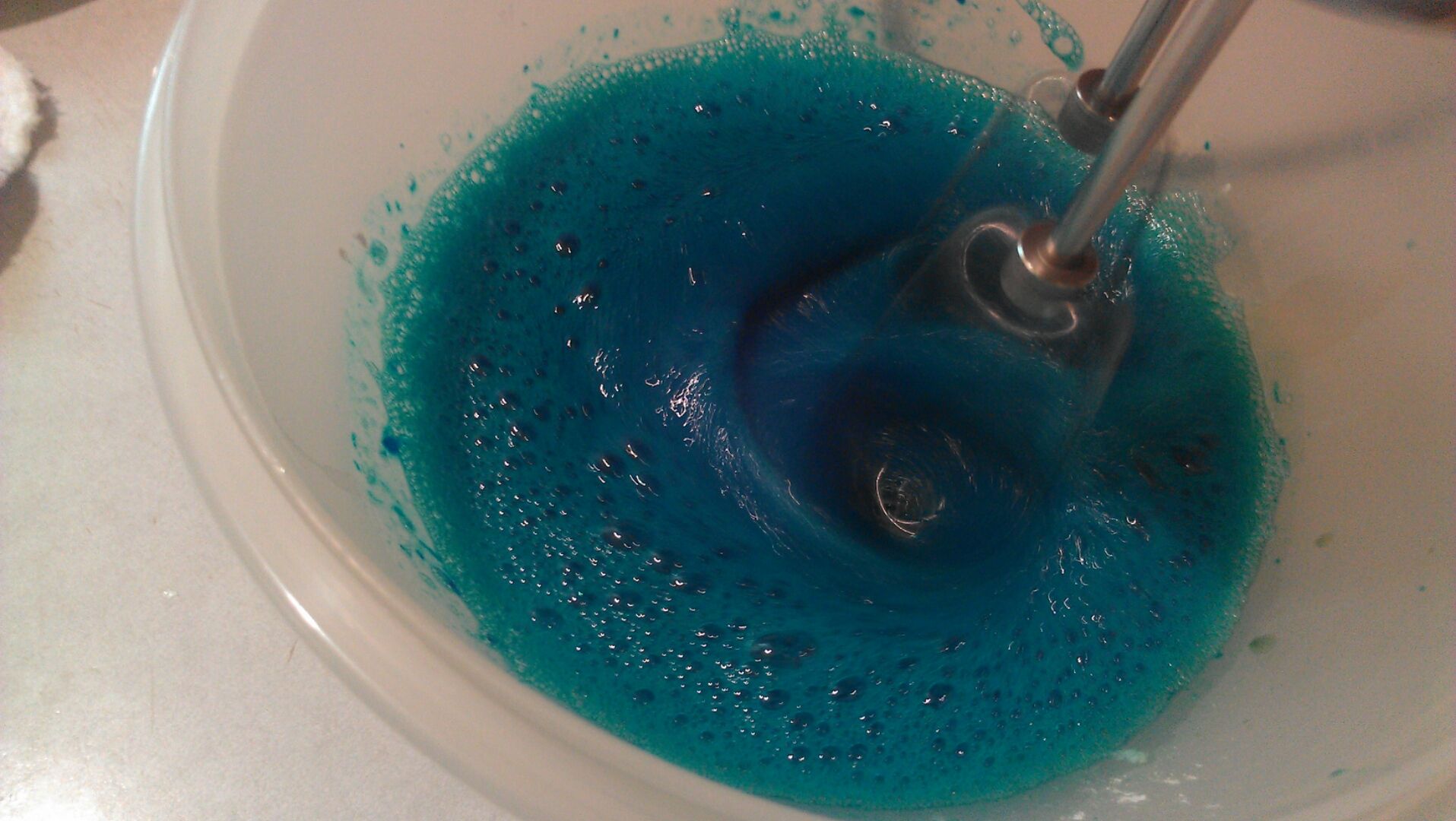
This has become almost pure foam, but will quickly fall apart and melt back into a more liquidy form if you stop and leave it alone.

Notice how we're getting 'waves' now that have the illusion of looking thicker.
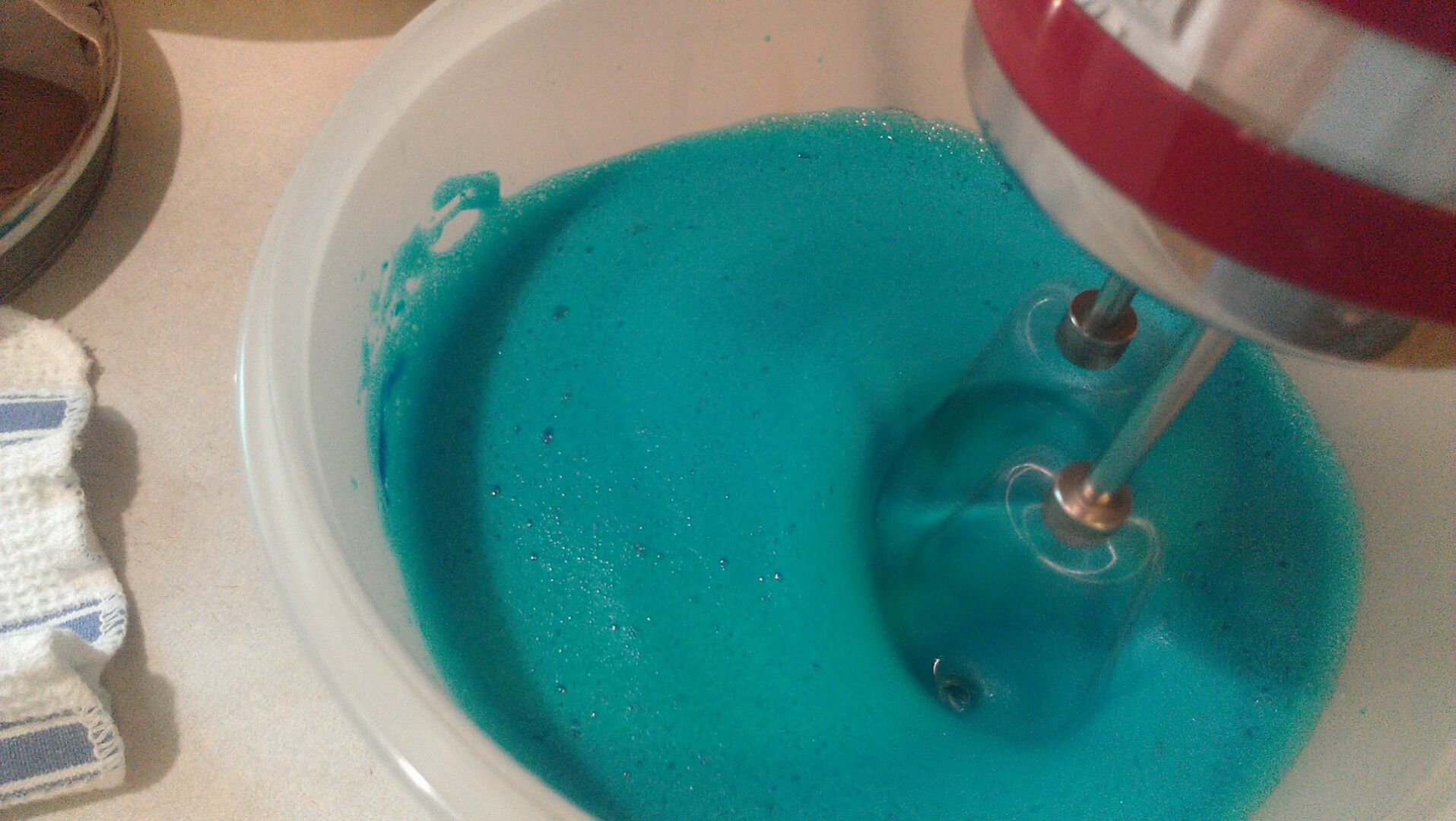
And thicker. When the waves start holding their shape, you've almost reached the 'soft peak' stage.
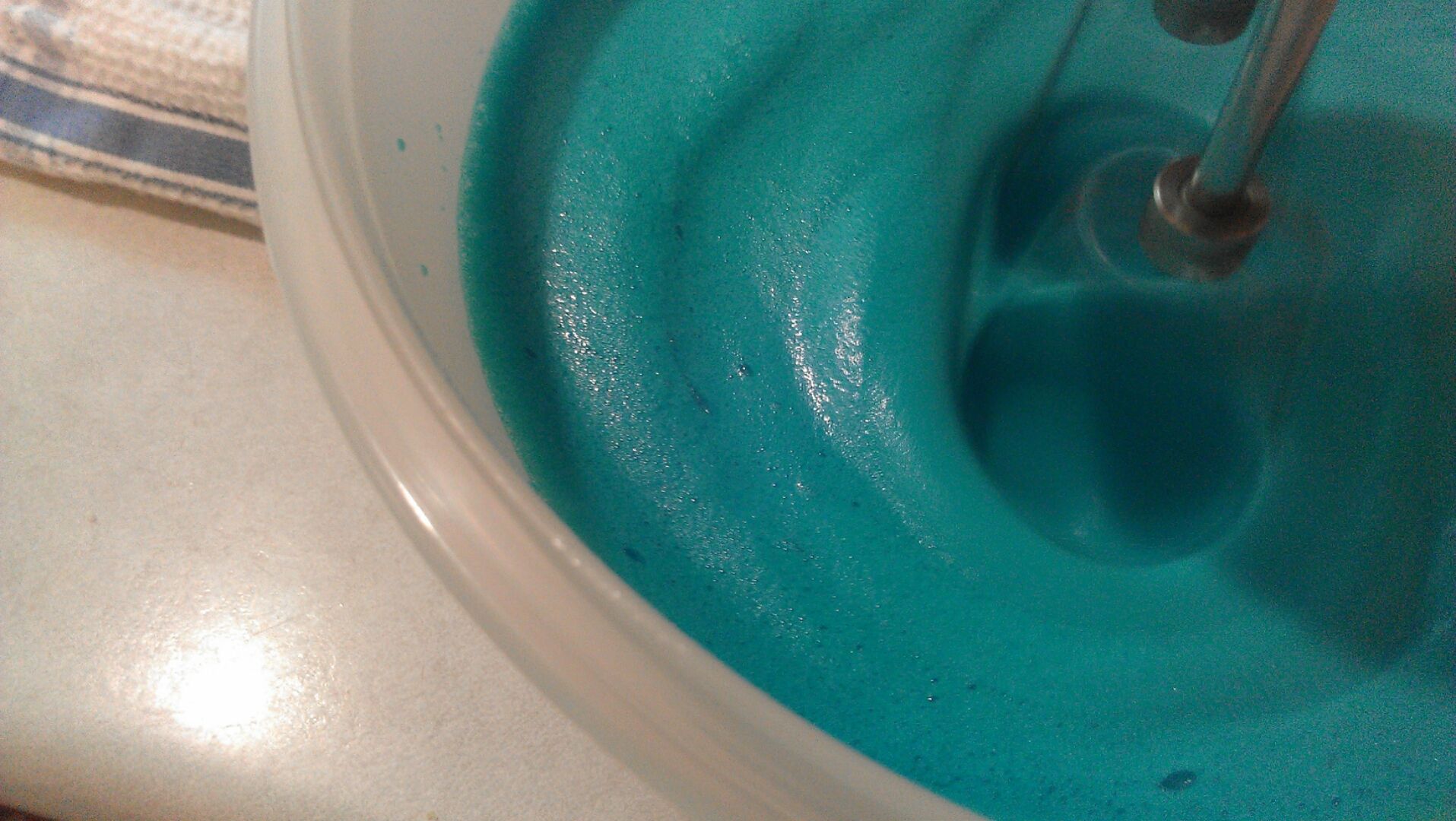
Which looks like this, soft peaks that hold their shape when you stop. You'll see why they're called soft when you reach the stiff peak stage. At this point stop and get your sugar and then stir whipping it in a tablespoon at a time. You don't need to add extra sugar when you use a couple more whites.
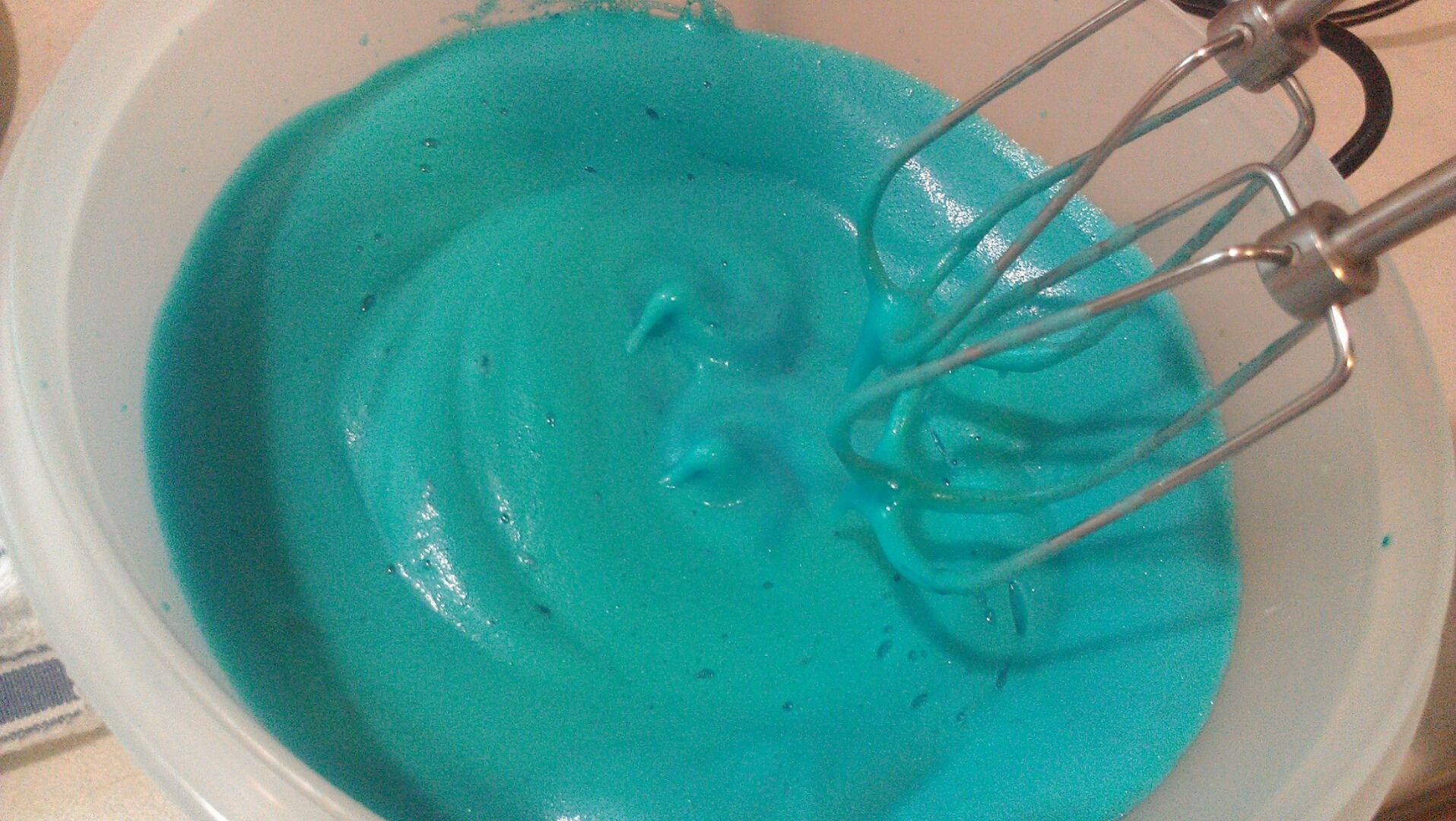
The sugar helps the froth smooth out into a glossy fluff. Keep going for a bit.
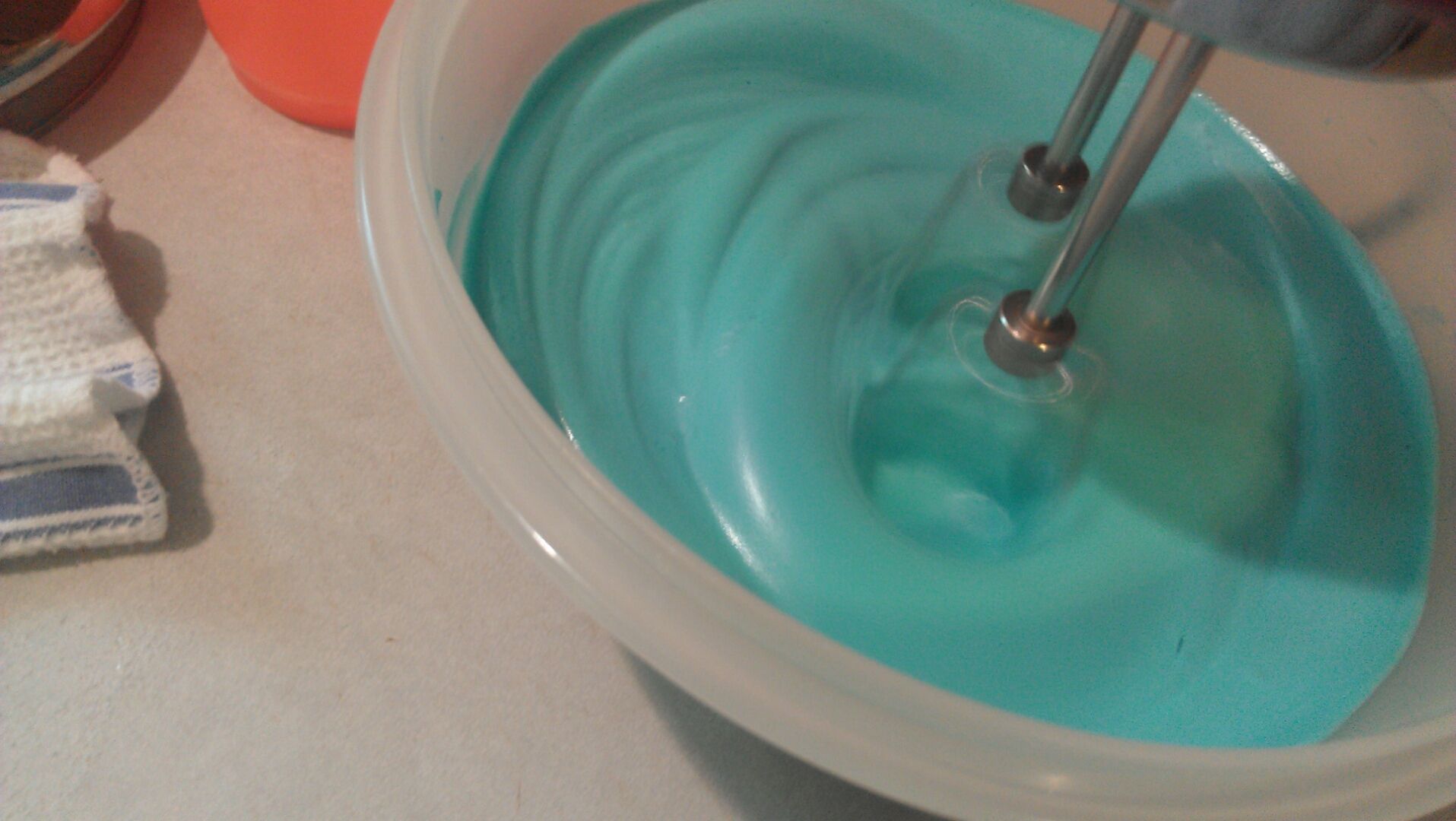
These are stiff peaks. When your froth has finally turned into something that looks like marshmallow creme and holds a really good shape when you stop whipping, you've finally made meringue.
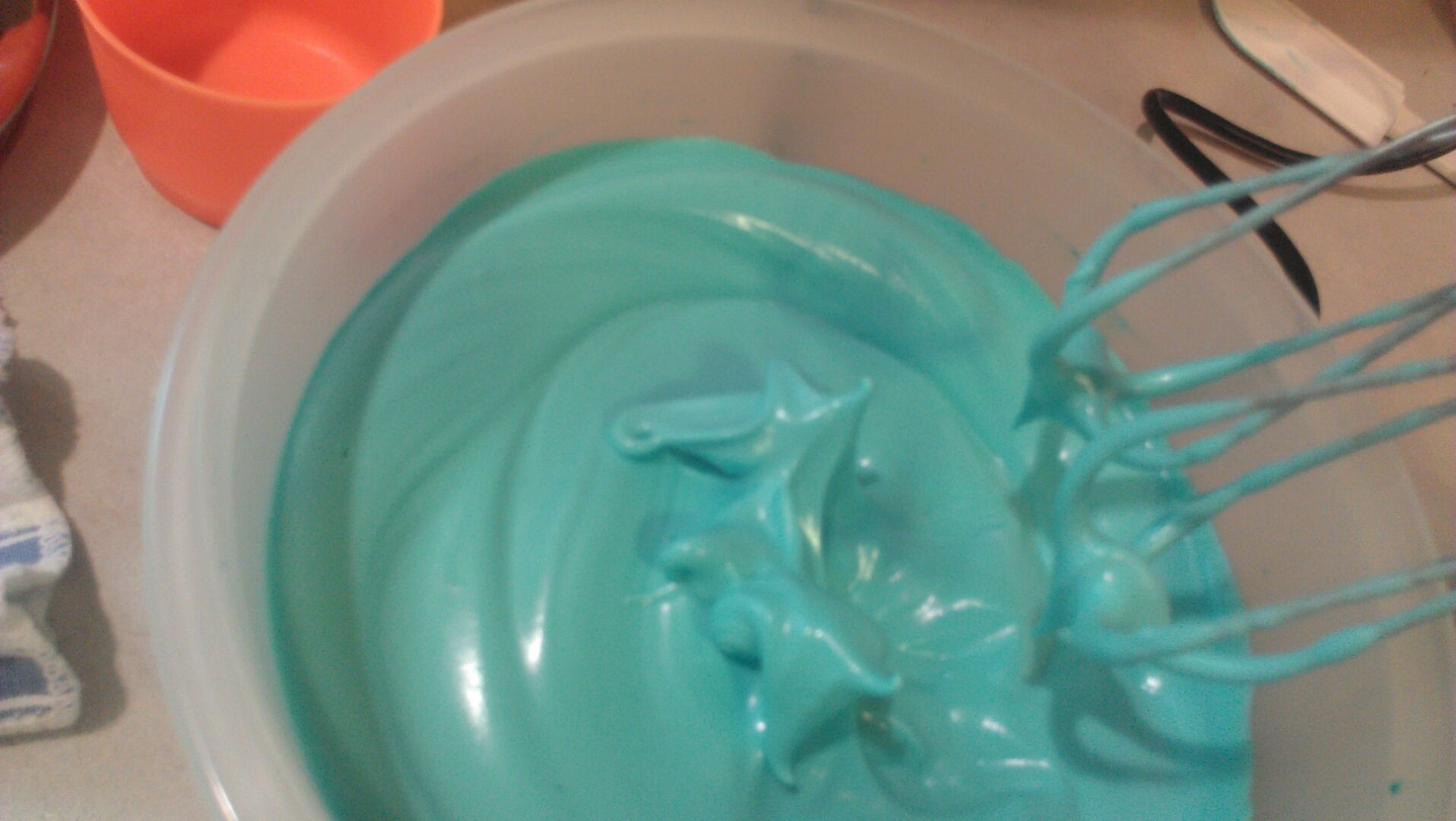
There are many things you can do with meringue, but this one is going onto a pie.
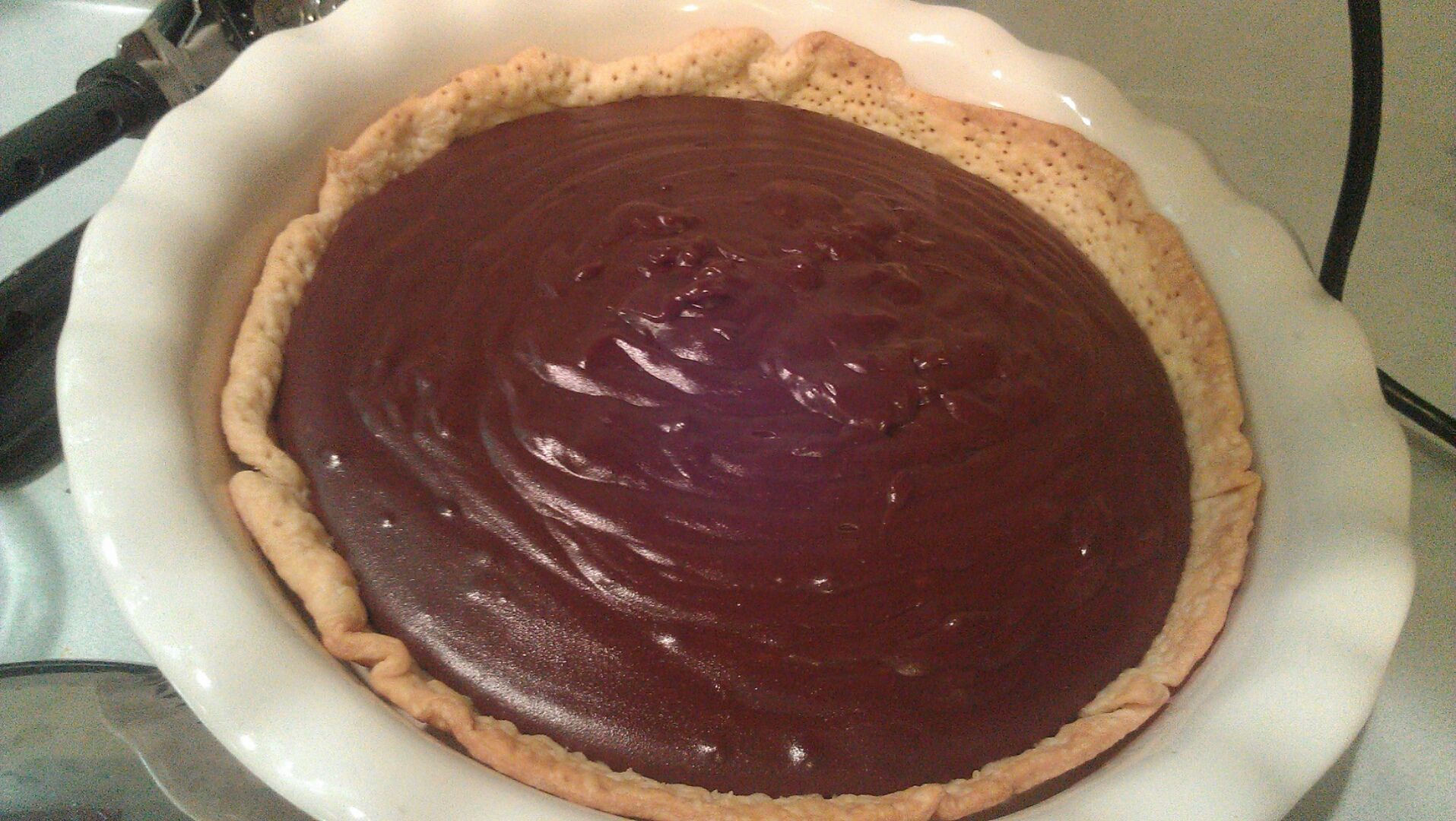
I get so bored with the same old meringue, I started playing with shapes and colors this year. Maybe in a few months I can make something really super cool. But for now, I've got the basics down well enough to play with shaping waves. This seems to be turning into an activated Stargate portal.
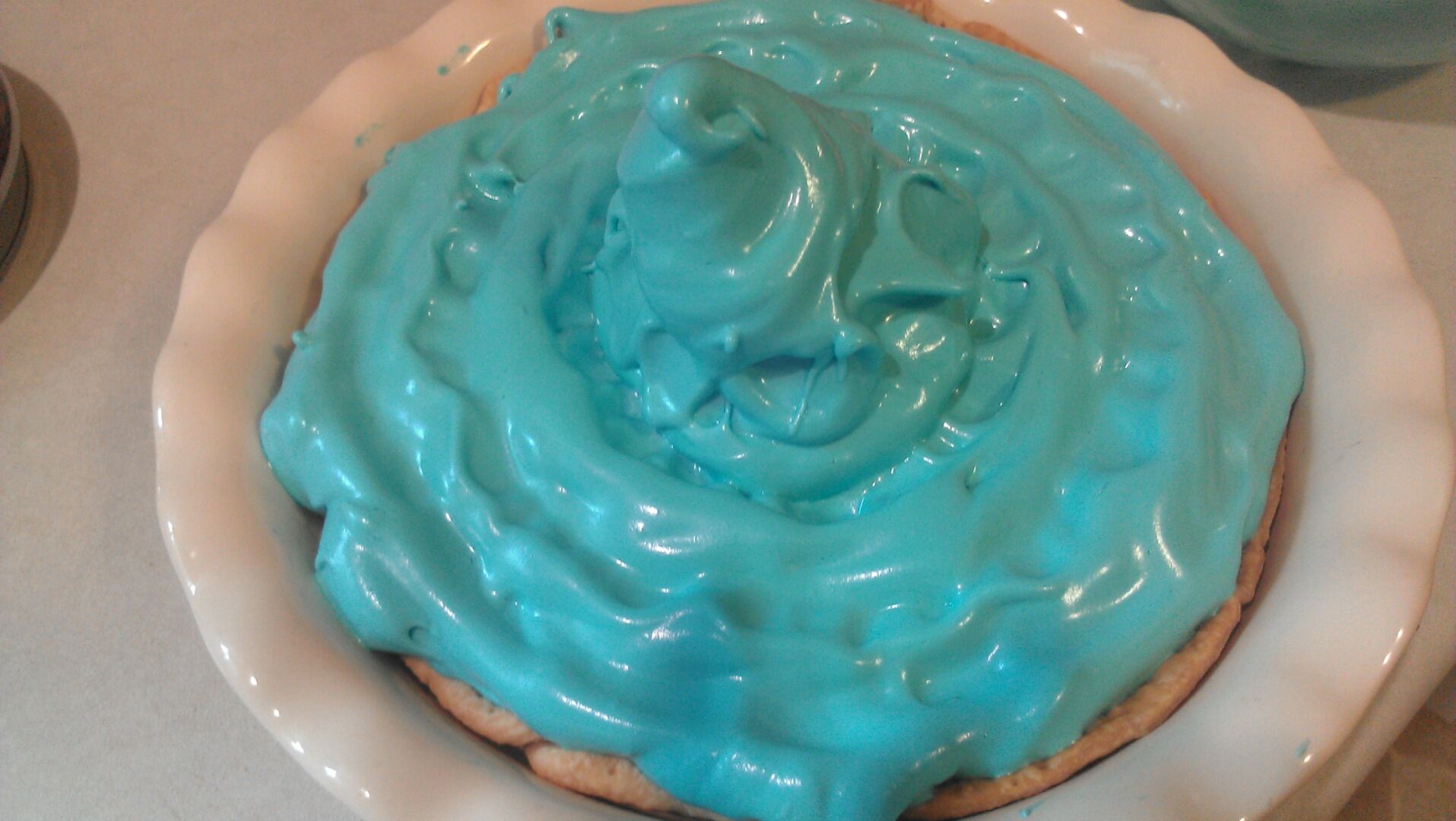
Bake your meringue in a preheated 350 degree oven for *about* 15 minutes, you really need to keep an eye on it because once it starts to brown, it can go black kinda fast, just like a marshmallow over a campfire.
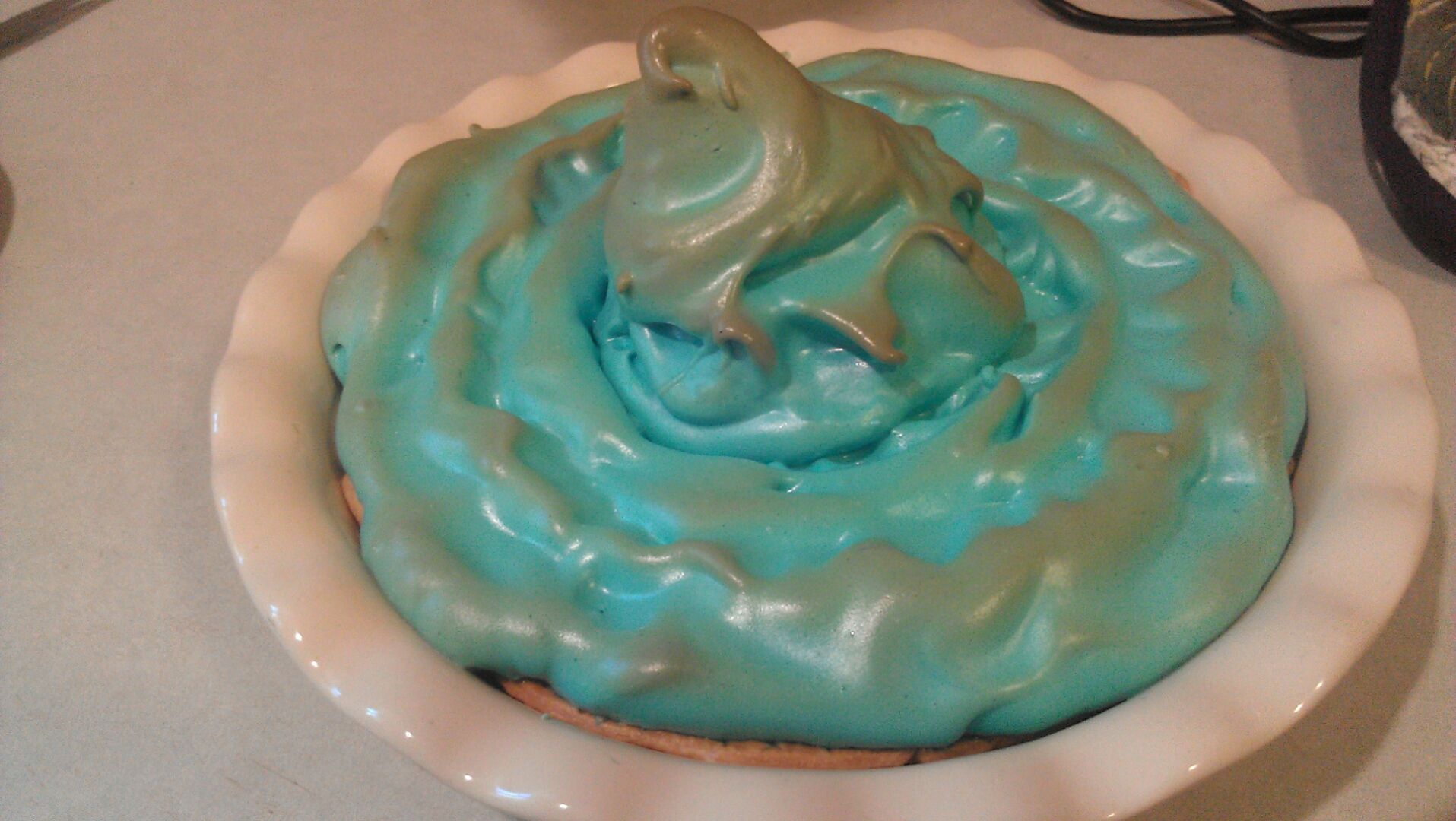
Sometimes your meringue will 'weep' back into the pie. Not to fear. It's liquid sugar and doesn't spoil a thing.
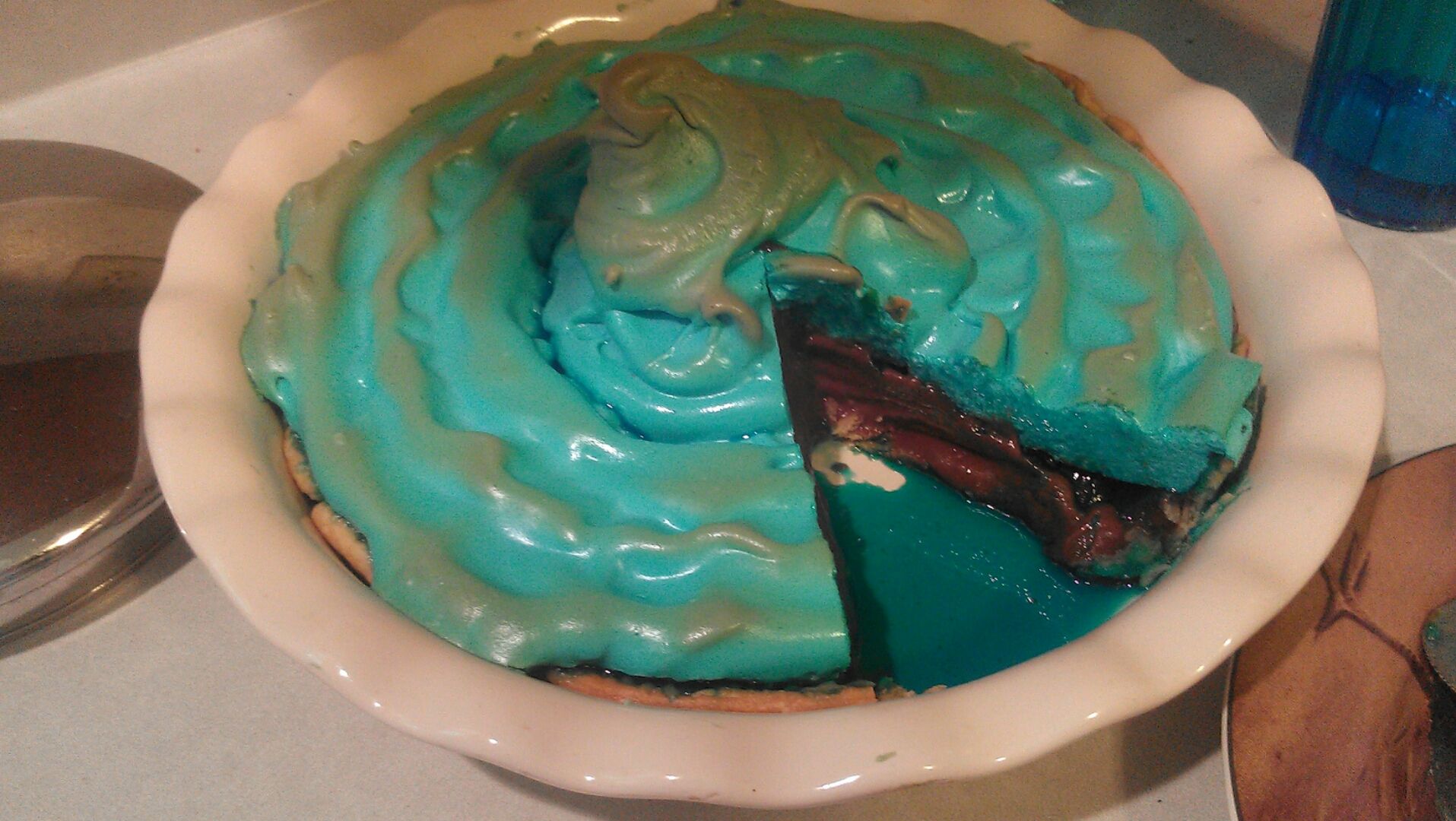
Question from the original comments- There is one question I have about all this. Because I tried making them last week and flunked. I was using diabetic sugar. Do you know how much less you use in it? At least I think you use less. Thanks for the information. Bro. Doc
My answer- I have never tried using anything other than granulated sugar, but I found someone else who has gotten the hang of it at Sugar-Free Meringue Recipe790: You're wasting your energy attempting to force my cooperation.
I have no sense of self-preservation and I can always be reassembled.

Comment
Comment